Home » Posts tagged 'gpl' (Page 4)
Tag Archives: gpl
Sneak Peek: Incredible PBX with FreePBX 13 GPL Modules
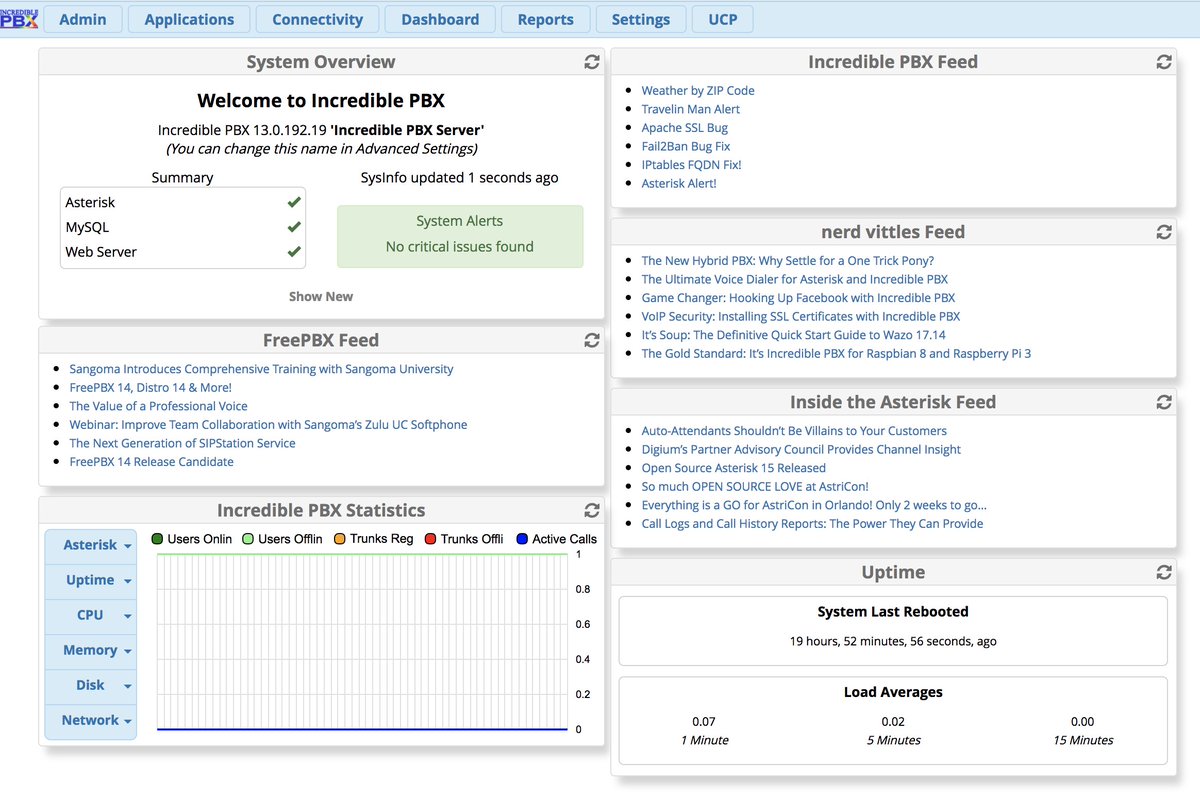
[iframe-popup id="4″]
As many of you know, the Asterisk® 13.16 and 13.17 releases caused serious breakage with FreePBX® 12 GPL deployments. These have been resolved in the new Asterisk 13.18 release candidate, but it prompted us to do a little exploring for alternatives while many of you were partying at AstriCon in Orlando last week. To give credit where credit is due, the Sangoma developers have made some impressive improvements with their FreePBX 13 release. And now we’re pleased to introduce a preview of the new Incredible PBX 13-13 platform featuring almost all of the FreePBX 13 GPL modules. For those that prefer lean and mean implementations of Asterisk, this preview edition is for you. You get the latest version of Asterisk compiled from source, and you get a base install of the FreePBX 13 GPL modules. The only preconfigured component in the build is the Travelin’ Man 3 firewall which locks down your server to trusted providers and IP addresses which you authorize.
We would hasten to add that Incredible PBX 13-13 is still a work in progress. Changes and improvements are released almost daily. If you don’t have that pioneering spirit, then you may wish to hold off for a few more weeks until all of the kinks have been worked out. Having said that, part of the fun of participating in the open source community is rolling up your sleeves and trying out new things. Offering your suggestions as we move along almost always yields a better end product both for you and the rest of the open source community. While we don’t ordinarily recommend deployment of preview editions for production systems, it’s worth noting that both Asterisk 13 and FreePBX 13 have a lot of miles on them and are generally regarded as the production-ready platforms for serious deployments.
So let’s get started. You can install Incredible PBX 13-13 Lean on a dedicated server, on a virtual machine platform such as VirtualBox, or a Cloud-based server such as Vultr. We recommend a minimum 1GB of RAM although you can get away with 512MB of RAM if you also create a swapfile. We’ve provided a script to do it for you. Depending upon the number of users your server will be supporting, we recommend a disk capacity of 10-30 GB. Last but not least, you need a reliable Internet connection.
Before you can install Incredible PBX 13-13 Lean, you’ll need a basic Linux platform. For this build, you can start by deploying a minimal install of CentOS 6 or 7. The Incredible PBX installer will load all of the necessary components to support Asterisk and FreePBX as well as future Incredible PBX applications.
Installing a Base CentOS Operating System
Let’s begin by installing 64-bit CentOS 6.9 or 7 on your favorite hardware or Desktop. Or you may prefer to use a Cloud provider1 that already offers a preconfigured CentOS image. Two reasons we prefer Vultr are (1) Incredible PBX runs fine on their least costly $2.50/mo. platform and (2) for an extra 50 cents a month, you can add automatic backups to your server platform. In you’re using a Cloud platform, you can skip the rest of this section. Just choose CentOS 6 or 7 as the default operating system for your cloud-based server.
For those using a dedicated hardware platform or wishing to install CentOS as a virtual machine, the drill is the same. Start by downloading the 64-bit CentOS 6.9 minimal ISO or the CentOS 7 minimal ISO. Burn the ISO to a DVD unless you’ll be booting from the ISO on a virtual machine platform such as VirtualBox. On virtual platforms, we recommend at least 1GB RAM and a 20GB dedicated drive. For VirtualBox, here are the settings:
Type: Linux
Version: RedHat 64-bit
RAM: 1024MB
Default Drive Options with 10GB+ space
Create
Settings->System: Enable IO APIC and Disable HW Clock (leave rest alone)
Settings->Audio: Enable
Settings->Network: Enable, Bridged
Settings->Storage: Far right CD icon (choose your ISO)
Start
Boot your server with the ISO, and start the CentOS install. Here are the simplest installation steps:
Choose Language and Click Continue
Click: Install Destination (do not change anything!)
Click: Done
Click: Network & Hostname
Click: ON
Click: Done
Click: Begin Installation
Click: Root Password: password, password, Click Done twice
Wait for Minimal Software Install and Setup to finish
Click: Reboot
Installing Incredible PBX 13-13 Lean Preview
Once you have CentOS up and running, log into your server as root and issue the following commands to kick off the Incredible PBX install. It’s a two-step process. First, the installer will bring your version of CentOS up to current specs and load the necessary packages to support Asterisk and FreePBX. The first stage setup takes about 10-15 minutes.
cd /root yum -y install net-tools nano wget tar wget http://incrediblepbx.com/incrediblepbx-13-13-LEAN.tar.gz tar zxvf incrediblepbx-13-13-LEAN.tar.gz rm -f incrediblepbx-13-13-LEAN.tar.gz ./create-swapfile-DO ./IncrediblePBX-13-13.sh
When the base install finishes, your server will reboot. Simply log back in as root and run the installer a second time using an SSH terminal or Putty. You’ll be prompted whether to implement Google Voice plain text or OAuth 2 passwords. OAuth is strongly recommended. Make your selection, and the installer will work its magic. Come back in 15 minutes.
./IncrediblePBX-13-13.sh
Reboot one final time when the installer finishes the setup, and your server should be ready to go. Log back in as root. This will kick off the Automatic Update Utility to load any last minute additions, bug fixes, and security patches. After the status menu displays, run the following apps to set a very secure admin password for web access to the GUI and to choose your default time zone:
/root/admin-pw-change /root/timezone-setup
WebMin is also installed and configured as part of the base install. The root password for access is the same as your Linux root password. We strongly recommend that you not use WebMin to make configuration changes to your server. You may inadvertently damage the operation of your server beyond repair. WebMin is an excellent tool to LOOK at how your server is configured. When used for that purpose, we highly recommend WebMin as a way to become familiar with your Linux configuration.
Using the Incredible PBX 13-13 Web GUI
Most of the configuration of your PBX will be performed using the web-based Incredible PBX GUI with its FreePBX 13 GPL modules. Use a browser pointed to the IP address of your server and choose Incredible PBX Admin. Log in as admin with the password you configured in the previous step. HINT: You can always change it if you happen to forget it.

To get a basic system set up so that you can make and receive calls, you’ll need to add a VoIP trunk, create one or more extensions, set up an inbound route to send incoming calls to an extension, and set up an outbound route to send calls placed from your extension to a VoIP trunk that connects to telephones in the real world. You’ll also need a SIP phone or softphone to use as an extension on your PBX. Our previous tutorial will walk you through this setup procedure. Over the years, we’ve built a number of command line utilities including a script to preconfigure SIP trunks for more than a dozen providers in seconds. You’ll find links to all of them here. Come join the discussion on the PIAF Forum and enjoy the ride!
Now Serving: The Incredible PBX 13-13 Whole Enchilada Upgrade
Continue Reading: Configuring Extensions, Trunks & Routes
Published: Monday, October 23, 2017

Need help with Asterisk? Visit the PBX in a Flash Forum.
Special Thanks to Our Generous Sponsors
FULL DISCLOSURE: ClearlyIP, Skyetel, Vitelity, DigitalOcean, Vultr, VoIP.ms, 3CX, Sangoma, TelecomsXchange and VitalPBX have provided financial support to Nerd Vittles and our open source projects through advertising, referral revenue, and/or merchandise. As an Amazon Associate and Best Buy Affiliate, we also earn from qualifying purchases. We’ve chosen these providers not the other way around. Our decisions are based upon their corporate reputation and the quality of their offerings and pricing. Our recommendations regarding technology are reached without regard to financial compensation except in situations in which comparable products at comparable pricing are available from multiple sources. In this limited case, we support our sponsors because our sponsors support us.
 BOGO Bonaza: Enjoy state-of-the-art VoIP service with a $10 credit and half-price SIP service on up to $500 of Skyetel trunking with free number porting when you fund your Skyetel account. No limits on number of simultaneous calls. Quadruple data center redundancy. $25 monthly minimum spend required. Tutorial and sign up details are here.
BOGO Bonaza: Enjoy state-of-the-art VoIP service with a $10 credit and half-price SIP service on up to $500 of Skyetel trunking with free number porting when you fund your Skyetel account. No limits on number of simultaneous calls. Quadruple data center redundancy. $25 monthly minimum spend required. Tutorial and sign up details are here.
 The lynchpin of Incredible PBX 2020 and beyond is ClearlyIP components which bring management of FreePBX modules and SIP phone integration to a level never before available with any other Asterisk distribution. And now you can configure and reconfigure your new Incredible PBX phones from the convenience of the Incredible PBX GUI.
The lynchpin of Incredible PBX 2020 and beyond is ClearlyIP components which bring management of FreePBX modules and SIP phone integration to a level never before available with any other Asterisk distribution. And now you can configure and reconfigure your new Incredible PBX phones from the convenience of the Incredible PBX GUI.
 VitalPBX is perhaps the fastest-growing PBX offering based upon Asterisk with an installed presence in more than 100 countries worldwide. VitalPBX has generously provided a customized White Label version of Incredible PBX tailored for use with all Incredible PBX and VitalPBX custom applications. Follow this link for a free test drive!
VitalPBX is perhaps the fastest-growing PBX offering based upon Asterisk with an installed presence in more than 100 countries worldwide. VitalPBX has generously provided a customized White Label version of Incredible PBX tailored for use with all Incredible PBX and VitalPBX custom applications. Follow this link for a free test drive!
 Special Thanks to Vitelity. Vitelity is now Voyant Communications and has halted new registrations for the time being. Our special thanks to Vitelity for their unwavering financial support over many years and to the many Nerd Vittles readers who continue to enjoy the benefits of their service offerings. We will keep everyone posted on further developments.
Special Thanks to Vitelity. Vitelity is now Voyant Communications and has halted new registrations for the time being. Our special thanks to Vitelity for their unwavering financial support over many years and to the many Nerd Vittles readers who continue to enjoy the benefits of their service offerings. We will keep everyone posted on further developments.
Some Recent Nerd Vittles Articles of Interest…
- Some of our links refer users to Amazon or other service providers when we find their prices are competitive for the recommended products. Nerd Vittles receives a small referral fee from these providers to help cover the costs of our blog. We never recommend particular products solely to generate commissions. However, when pricing is comparable or availability is favorable, we support these providers because they support us. [↩]
Twofer Tuesday: 2 Cloud Servers for the Price of a RasPi

It’s been more than a year since we last chatted about Cloud At Cost. Because they’re in the midst of yet another 50% off Fire Sale and to close out February with a bang, it seemed like a good time to take a fresh look at a terrific way to get started with Linux. For today’s $35 cloud project, we’re going to build a free WordPress server and a free commercial PBX compliments of 3CX. For what it’s worth, we’ve been running a PIAF5 server at CloudAtCost for more than four months without a single hiccup. It provides flawless Google Voice calling from either a connected SIP phone or from the 3CX Client running on a SIM-free Android phone or iPhone. See our recent article for tips on setting up a SIM-free mobile phone.
For those coming from the Windows World, Linux can be a little intimidating. Learning with a Cloud-based server presents its own challenges because of the security issues when your server sits on the public Internet. And then there’s the cost factor. Not everyone has several hundred dollars to buy hardware and, frankly, learning about Linux on a $35 Raspberry Pi can drive most folks to drink. So today we’ll show you another way. It’s not necessarily a better way. But it’s different, and it’s loads of fun for not much money. Today’s project takes about an hour, and you’ll have two terrific Linux applications to play with for life when we’re finished.
There’s lots to hate at Cloud At Cost, a Canadian provider that offers virtual machines in the cloud for a one-time fee with no recurring charges. For $35, you currently get two virtual machine platforms, and each has 512MB of RAM, 10GB of storage, and a gigabit Internet connection FOR LIFE. We haven’t seen a week go by when Cloud at Cost didn’t offer some sort of discount. Today it’s 50% off which brings the per server cost down to $17.50 each. That’s less than most lunches these days. If you don’t like half off and would prefer to wait for a better discount, check their Twitter feed every few days. So that’s the good news. But, if 99.999% reliability, performance, and excellent customer support are your must-haves, then look elsewhere. So why would anyone in their right mind sign up for a cloud solution that didn’t offer those things? Did we mention it’s $17.50 for a lifetime cloud server!
If you take our recommendation, you’ll need to go into this with the right attitude. It’s not going to be flawless perfection computing. It’s a sandbox on which to experiment with Linux, and VoIP, and Cloud Computing. Will your virtual machine disintegrate at some juncture? Maybe so. We’ve had about a third of ours fail at some point. But you can rebuild them easily, especially if you keep a backup. Our experience is that the first couple days are critical. If you start seeing sluggish performance which degenerates to zero, don’t waste your time. Take good notes as you go along, delete the virtual machine, and rebuild a new one. It won’t cost you a dime, and it’ll save you hours of frustration. We suspect that bad folks get onto some of the servers and delight in bringing the machines to their knees. So the quicker you cut your losses, the better off you will be. Is CloudAtCost a good solution for production use? Don’t risk it unless waterboarding is your favorite sport. It’s probably not gonna work, and you WILL be disappointed. Repeat after me: IT’S A SANDBOX!
Building a LAMP Server in the Cloud
Our first objective today is to show you how to build a rock-solid, secure Linux server in the Cloud with all the bells and whistles that make Linux the server platform of choice for almost every organization in the world. We’ll continue by showing you how to embellish the platform with WordPress to do something that’s special for you whether it’s your own blog like Nerd Vittles, or a school newspaper, or an on-line shopping site to sell comic books. The basic foundation for most Linux platforms is called a LAMP server which stands for Linux, Apache, MySQL, and PHP. Linux is an open source operating system that includes contributions from thousands of developers around the world. Apache is the web server platform on which most commercial businesses stake their reputation. MySQL is the open source database management system now owned by Oracle. If it’s good enough for Facebook, it’s good enough for you. And PHP is THE web-based programming language that will let you build almost any application using Linux, Apache, and MySQL.
So what’s the big deal? There are thousands of online tutorials that will show you how to build a LAMP server. For long time readers of Nerd Vittles, you already know that the component we continually stress is security. Without that, the rest really doesn’t matter. You’ll be building a platform for someone else to hijack and use for nefarious purposes. When we’re finished with today’s Project #1, you’ll have a cloud-based LAMP server that is totally invisible to the rest of the world with the exception of its web interface. And we’ll show you a simple way to reduce the exposure of that web interface to some of its most likely attackers. Will it be 100% secure? Nope. If you have a web server on the public Internet, it’s never going to be 100% secure because there’s always the chance of a software bug that nobody has yet discovered and corrected. THAT’S WHAT BACKUPS ARE FOR!
Creating a CentOS Machine in the Cloud
To get started, you’ve got to plunk down your $35 at Cloud at Cost. This buys you two server platforms while they’re cheap! Once you’ve paid the piper, they will send you credentials to log into the Cloud at Cost Management Portal. Change your password IMMEDIATELY after logging in. Just go to SETTINGS and follow your nose.
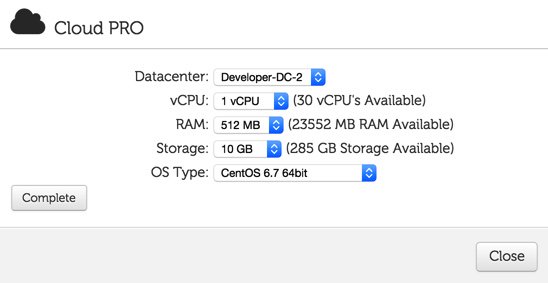
To create your first virtual machine, click on the CLOUDPRO button and click Add New Server. If you’ve only purchased the $17.50 CloudPRO 1 platform, then you’ll need all of the available resources shown in the pick list. Otherwise, choose 1 CPU, 512MB RAM, and 10GB storage for your first server. Leave CentOS 6.7 64bit selected as the OS Type and click Complete. Depending upon the type of special pricing that Cloud at Cost is offering when you sign up, the time to build your virtual machine can take anywhere from a minute to the better part of a day. We’ve learned to build new virtual machines at night, and they’re usually available for use by the next morning. Luckily, this slow performance does not impact existing virtual machines that already are running in their hosting facility.
Initial Configuration of Your CentOS 6 VM

With a little luck, your virtual machine soon will appear in your Cloud at Cost Management Portal and look something like what’s shown above. The red arrow points to the i button you’ll need to click to decipher the password for your new virtual machine. You’ll need both the IP address and the password for your new virtual machine in order to log into the server which is now up and running with a barebones CentOS 6.7 operating system. Note the yellow caution flag. That’s telling you that Cloud at Cost will automatically shut down your server in a week to save (them) computing resources. You can change the setting to keep your server running 24/7. Click Modify, Change Run Mode, and select Normal – Leave Powered On. Click Continue and OK to save your new settings.

Finally, you’ll want to change the Host Name for your server to something more descriptive than c7…cloudpro.92… Click the Modify button again and click Rename Server to make the change. Your management portal then will show the new server name as shown above.
Logging into Your CentOS 6 VM
In order to configure and manage your new CentOS 6 virtual machine, you’ll need to log into the new server using either SSH or, for Windows users, Putty. After installing Putty, run it and log in to the IP address of your VM with username root and the password you deciphered above. On a Mac, open a Terminal session and issue a command like this using the actual IP address of your new virtual machine:
ssh root@12.34.56.78
Before you do anything else, reset your root password to something very secure: passwd
Installing the LAMP Server Basics
Now we’re ready to build your LAMP server platform. We’ve chopped this up into lots of little steps so we can explain what’s happening as we go along. There’s nothing hard about this, but we want to document the process so you can repeat it at any time. As we go along, just cut-and-paste each clump of code into your SSH or Putty session and review the results to make sure nothing comes unglued. If something does, the beauty of virtual machines is you can delete them instantly within your management portal and just start over whenever you like. So here we go…
We’ll begin by permanently turning off SELINUX which causes more problems than it solves. The first command turns it off instantly. The second line assures that it’ll stay off whenever you reboot your virtual machine.
setenforce 0 sed -i s/SELINUX=enforcing/SELINUX=disabled/g /etc/selinux/config
First, let’s address a couple of CloudAtCost quirks that may cause problems down the road. CloudAtCost has a nasty habit of not cleaning up after itself with fresh installs. The net result is your root password gets reset every time you reboot.
killall plymouthd echo killall plymouthd >> /etc/rc.local rm -f /etc/rc3.d/S97*
Now let’s bring CentOS 6.7 up to current CentOS 6.8 specs and add a few important applications:
yum -y update yum -y install nano wget expect net-tools dialog git xz yum -y install kernel-headers yum -y install kernel-devel reboot
After reboot, log back in as root. Now we’ll set up your Apache web server and configure it to start whenever you reboot your server:
yum -y install httpd service httpd start chkconfig httpd on
Next, let’s set up your MySQL server, bring it on line, and make sure it restarts after server reboots. Unless you plan to add Asterisk® and FreePBX® to your server down the road, you’ll want to uncomment the two commands that begin with # by removing the # symbol and replacing new-password with a very secure password for your root user account in MySQL. Be sure to run the last command to secure your server. After logging in, the correct answers are n,Y,Y,Y,Y.
yum -y install mysql mysql-server service mysqld start chkconfig mysqld on #/usr/bin/mysqladmin -u root password 'new-password' #/usr/bin/mysqladmin -u root -p -h localhost.localdomain password 'new-password' mysql_secure_installation
Next, we’ll set up PHP and configure it to work with MySQL:
yum -y install php yum -y install php-mysql service httpd restart
Finally let’s get SendMail installed and configured. Insert your actual email address in the last line and send yourself a test message to be sure it’s working. Be sure to check your spam folder since the message will show a sender address of localhost which many email systems including Gmail automatically identify as spam.
yum -y install sendmail rpm -e postfix service sendmail restart yum -y install mailx echo "test" | mail -s testmessage youracctname@yourmailserver.com
Installing Supplemental Repositories
One of the beauties of Linux is not being totally dependent upon CentOS for all of your packaged applications. Let’s add a few other repositories that can be used when you need to add a special package that is not in the CentOS repository. Let’s start with EPEL. We’ll disable it by default and only use it when we need it.
yum -y install http://download.fedoraproject.org/pub/epel/6/x86_64/epel-release-6-8.noarch.rpm sed -i 's|enabled=1|enabled=0|' /etc/yum.repos.d/epel.repo
We actually need the EPEL repo to install Fail2Ban for monitoring of attacks on certain Linux services such as SSH:
yum --enablerepo=epel install fail2ban -y cd /etc wget http://incrediblepbx.com/fail2ban-lamp.tar.gz tar zxvf fail2ban-lamp.tar.gz
Another important repository is REMI. It is especially helpful if you decide to upgrade PHP from the default version 5.3 to one of the newer releases: 5.5 or 5.6. In this case, you’ll want to activate the specific repository to support the release you choose in /etc/yum.repos.d/remi-safe.repo.
yum -y install http://rpms.famillecollet.com/enterprise/remi-release-6.rpm sed -i 's|enabled=1|enabled=0|' /etc/yum.repos.d/remi-safe.repo
One final repository to have on hand is RPMForge, now renamed RepoForge. We’ll use it in a bit to install a dynamic DNS update utility which you actually won’t need at CloudAtCost since your server is assigned a static IP address. But it’s handy to have in the event you wish to assign a free FQDN to your server anyway.
yum -y install http://incrediblepbx.com/rpmforge-release-0.5.3-1.el6.rf.x86_64.rpm sed -i 's|enabled = 1|enabled = 0|' /etc/yum.repos.d/rpmforge.repo
Country Blocking with IPSET
We’ll use the EPEL repo to install ipset, a terrific addition to the IPtables Linux firewall that lets you quickly block entire countries from accessing your server:
yum --enablerepo=epel install ipset -y
Next, we’ll add a sample script that documents how the country blocking mechanism works with ipset. For a complete list of countries that can be blocked, go here. If you need a decoder badge to match abbreviations against country names, you’ll find it here. To add other countries, simply edit the shell script and clone lines 4-7 using the names of the countries and country zone files that you wish to add. Be sure to insert the new lines before the commands to restart iptables and fail2ban. This script will need to be run each time your server reboots and before IPtables is brought on line. We’ll handle that a little later.
echo "#\\!/bin/bash" > /etc/block-china.sh echo " " >> /etc/block-china.sh echo "cd /etc" >> /etc/block-china.sh echo "ipset -N china hash:net" >> /etc/block-china.sh echo "rm cn.zone" >> /etc/block-china.sh echo "wget -P . http://www.ipdeny.com/ipblocks/data/countries/cn.zone" >> /etc/block-china.sh echo "for i in \$(cat /etc/cn.zone ); do ipset -A china \$i; done" >> /etc/block-china.sh echo "service iptables restart" >> /etc/block-china.sh echo "service fail2ban restart" >> /etc/block-china.sh sed -i 's|\\\\||' /etc/block-china.sh chmod +x /etc/block-china.sh
Adding a Few Handy Utilities
If you’re like us, you’ll want to test the speed of your Internet connection from time to time. Let’s install a free script that you can run at any time by logging into your server as root and issuing the command: /root/speedtest.py. Here were our results from last year. Running speedtest on a new server we built today showed a vast improvement in performance. Downloads were over ten times as fast, and upload speeds more than tripled. In fact, we now are using two CloudAtCost servers to host the old PIAF3 repositories.
cd /root wget https://raw.githubusercontent.com/sivel/speedtest-cli/master/speedtest.py chmod +x speedtest.py

Next, let’s put in place a simple status display which will quickly tell you what’s running and what’s not. We’ve borrowed some GPL code from Incredible PBX to help you out. Run status-lamp at any time for a snapshot of your server.
cd /usr/local/sbin wget http://incrediblepbx.com/status-lamp.tar.gz tar zxvf status-lamp.tar.gz rm -f status-lamp.tar.gz sed -i 's|myip.pbxinaflash.com|myip.incrediblepbx.com|' /usr/local/sbin/status-lamp

Now we’ll put the Linux Swiss Army Knife in place. It’s called WebMin, and it provides a GUI to configure almost everything in Linux. Pick up a good WebMin book from your public library to get started. Once installed, you access WebMin from your browser at the IP address of your server on the default port of 10000: https://serverIPaddress:10000. It’s probably a good idea to change this port number and the commented out line shows how to do it with the new port being 9001 in the example. The way in which we typically configure the Linux firewall will block all access to WebMin except from an IP address which you have whitelisted, e.g. your home computer’s public IP address.
cd /root yum -y install perl perl-Net-SSLeay openssl perl-IO-Tty yum -y install http://prdownloads.sourceforge.net/webadmin/webmin-1.831-1.noarch.rpm #sed -i 's|10000|9001|g' /etc/webmin/miniserv.conf service webmin restart chkconfig webmin on
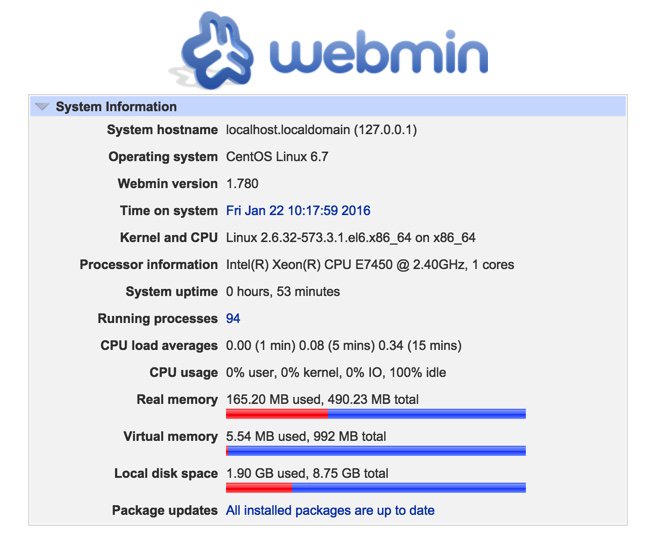
Configuring the Linux IPtables Firewall
RULE #1: DON’T BUILD SERVERS EXPOSED TO THE INTERNET WITHOUT SECURITY!
As installed by CloudAtCost, your server provides ping and SSH access from a remote computer and nothing else. The good news: it’s pretty safe. The bad news: it can’t do anything useful for anybody because all web access to the server is blocked. We want to fix that, tighten up SSH access to restrict it to your IP address, and deploy country blocking to show you how.
As we implement the firewall changes, you need to be extremely careful in your typing so that you don’t accidentally lock yourself out of your own server. A typo in an IP address is all it takes. The good news is that, if you do lock yourself out, you still can gain access via the CloudAtCost Management Portal by clicking the Console button of your virtual machine. Because the console is on the physical machine and the lo interface is whitelisted, you can log in and disable the firewall temporarily: service iptables stop. Then fix the typo and restart the firewall: service iptables start.
First, let’s download the new IPtables config file into your root folder and take a look at it.
cd /root wget http://incrediblepbx.com/iptables-lamp.tar.gz tar zxvf iptables-lamp.tar.gz
Now edit the /root/iptables-lamp file by issuing the command: nano -w /root/iptables-lamp
You can scroll up and down through the file with Ctl-V and Ctl-Y. Cursor keys work as well. Once you make changes, save your work: Ctl-X, Y, ENTER. You’re now an expert with the nano text editor, an absolutely essential Linux tool.
Here’s what that file actually looks like:
*filter :INPUT DROP [0:0] :FORWARD ACCEPT [0:0] :OUTPUT ACCEPT [0:0] -A INPUT -p tcp -m tcp --tcp-flags ACK ACK -j ACCEPT -A INPUT -m state --state ESTABLISHED,RELATED -j ACCEPT -A INPUT -p icmp -j DROP -A INPUT -i lo -j ACCEPT -A INPUT -p tcp ! --syn -m state --state NEW -j DROP -A INPUT -m state --state INVALID -j DROP -A INPUT -p tcp -m tcp --tcp-flags FIN,SYN,RST,PSH,ACK,URG NONE -j DROP -A INPUT -p tcp -m tcp --tcp-flags SYN,FIN SYN,FIN -j DROP -A INPUT -p tcp -m tcp --tcp-flags SYN,RST SYN,RST -j DROP -A INPUT -p tcp -m tcp --tcp-flags FIN,RST FIN,RST -j DROP -A INPUT -p tcp -m tcp --tcp-flags ACK,FIN FIN -j DROP -A INPUT -p tcp -m tcp --tcp-flags ACK,URG URG -j DROP -A INPUT -p tcp -m set --match-set china src -j DROP -A INPUT -p udp -m udp --dport 53 -j ACCEPT -A INPUT -p tcp -m tcp --dport 53 -j ACCEPT -A INPUT -p tcp -m tcp --dport 113 -j ACCEPT -A INPUT -p udp -m udp --dport 123 -j ACCEPT -A INPUT -p tcp -m tcp --dport 123 -j ACCEPT -A INPUT -m state --state NEW -m tcp -p tcp --dport 22 -j ACCEPT #-A INPUT -s 12.34.56.78 -j ACCEPT #-A INPUT -s yourFQDN.dyndns.org -j ACCEPT -A INPUT -p tcp -m tcp --dport 80 -j ACCEPT -A INPUT -j REJECT --reject-with icmp-host-prohibited -A FORWARD -j REJECT --reject-with icmp-host-prohibited COMMIT
Reminder: If you add another country to your block-china script, don’t forget to add a corresponding new country entry to your iptables file. See line 17 above that includes the word "china" for the syntax. There’s nothing much else to tweak except the two commented out (brown) lines that begin with #. First, remove the # symbol by moving the cursor to the right of the first one and hitting the backspace/delete key on your keyboard. Replace 12.34.56.78 with the public IP address of the computer from which you will be accessing your virtual machine. If you need multiple entries for multiple computers at different addresses, clone the line by pressing Ctrl-K and then Ctrl-U twice. Yes, we know. Some folks IP addresses change from time to time. In the next section, we’ll show you how to set up a Dynamic DNS entry with a utility that will keep track of your current IP address. In this case, uncomment the second commented line and replace yourFQDN.dyndns.org with your dynamic DNS address. Be very careful to assure that your FQDN is always on line. If the firewall cannot verify your DNS entry when it starts, the IPtables firewall will not start which means your server will be left unprotected. HINT: IP addresses are much safer because they are never verified.
Once you have your whitelisted addresses configured, comment out the port 22 line to keep the bad guys from trying to break into your server with SSH. Then save the file: Ctl-X, Y, ENTER. Next, issue the following commands to copy everything into place and restart the firewall.
mv /etc/sysconfig/iptables /etc/sysconfig/iptables.orig cp -p /root/iptables-lamp /etc/sysconfig/iptables echo "/etc/block-china.sh" >> /etc/rc.local /etc/block-china.sh
Always, always, always check to be sure your firewall is functioning: iptables -nL. If you don’t see your desktop computer’s public IP address near the end of the listing, then the firewall is dead. status-lamp should also show IPtables down. Check for an error message which will tell you the problematic line so you can correct it.
Implementing Dynamic DNS Service
There are a number of free and paid Dynamic DNS providers. The way this works is you choose a fully-qualified domain name (FQDN) to identify your computer. Then you run a dynamic DNS update utility periodically from that computer. It reports back the current public IP address of your computer and your provider updates the IP address assigned to your FQDN if it has changed. In addition to supporting sites with ever changing IP addresses, it also allows you to permanently assign an FQDN to your computer or server so that it can be accessed without using a cryptic IP address.
If that computer happens to be an Incredible PBX server or a LAMP server that you’ve set up using this tutorial, then the following will get the DNS client update utility loaded using the RPM Forge repository that we previously installed:
yum --enablerepo=rpmforge install ddclient -y
Similar DNS update clients are available for Windows, Mac OS X, and many residential routers. Then it’s just a matter of plugging in the credentials for your dynamic DNS provider and your FQDN. In the case of the CentOS client, the config file is /etc/ddclient/ddclient.conf. Now reboot your server and pick up a good book on Linux to begin your adventure.
Now For Some Fun…
First, let’s check things out and make sure everything is working as it should. With your favorite web browser, visit the IP address of your new server. You should see the default Apache page:

Next, let’s be sure that PHP is working as it should. While still logged into your server as root using SSH or Putty, issue the following commands and make up some file name to replace test4567 in both lines. Be sure to keep the .php file name extension. Note to gurus: Yes, we know the second line below is unnecessary if you remove the space after the less than symbol in the first line. Unfortunately, WordPress forces the space into the display which left us no alternative.
echo "< ?php phpinfo(); ?>" > /var/www/html/test4567.php sed -i 's|< |<|' /var/www/html/test4567.php
Now jump back to your web browser and access the new page you just created using the IP address of your server and the file name you made up: http://12.34.56.78/test4567.php
The PHPinfo listing will tell you everything you ever wanted to know about your web server setup including all of the PHP functions that have been enabled. That's why you want an obscure file name for the page. You obviously don't want to share that information with every bad guy on the planet. Remember. This is a public-facing web site that anyone on the Internet can access if they know or guess your IP address.
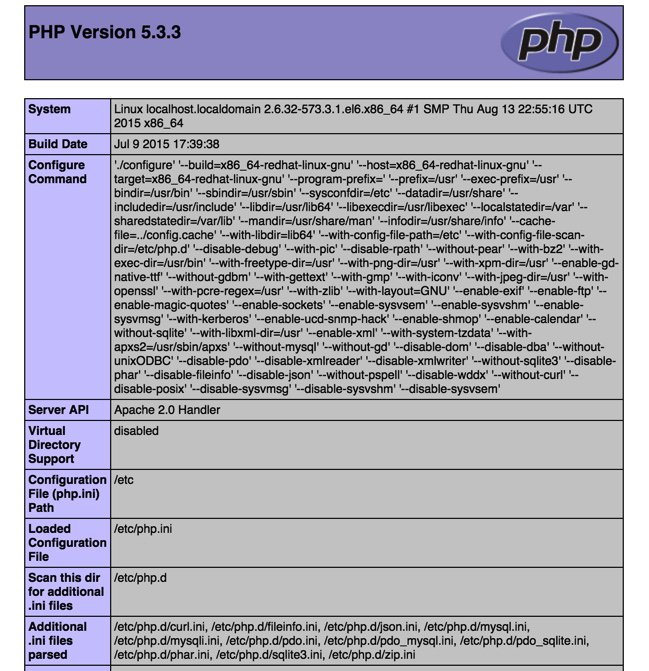
When you're ready to set up your own web site, just name it index.php and store the file in the /var/www/html directory of your server. In the meantime, issuing the following command will assure that anyone accessing your site gets a blank page until you're ready to begin your adventure:
echo " " > /var/www/html/index.php
Ready to learn PHP programming? There's no shortage of books to get you started.
Adding WordPress to Your LAMP Server
Where to begin with WordPress? What used to be a simple platform for bloggers has morphed into an all-purpose tool that makes building virtually any type of web site child's play. If you want to see what's possible, take a look at the templates and sample sites shown on WPZOOM. Unless you're an art major and savvy web designer, this will be the best $70 you ever spent. One of these templates will have your site up and running in minutes once we put the WordPress pieces in place. For the big spenders, $149 will give you access to over 50 gorgeous templates which you can download and use to your heart's content on multiple sites. And, no, your sites don't blow up after a year. You just can't download any additional templates or updates unless you renew your subscription. The other alternative is choose from thousands of templates that are provided across the Internet as well as in the WordPress application itself.
WordPress templates run the gamut from blogs to newsletters to photographer sites to e-commerce to business portfolios to video to travel to magazines to newspapers to education to food to recipes to restaurants and more. Whew! There literally is nothing you can't put together in minutes using a WordPress template. But, before you can begin, we need to get WordPress installed on your server. This is optional, of course. And, if you follow along and add WordPress, we've set it up in such a way that WordPress becomes the primary application for your site. Stated differently, when people use a browser to access your site, your WordPress template will immediately display. When we finish the basic WordPress setup and once you upload an image or two, you'll have a site that looks something like this:

Before you begin, we strongly recommend that you acquire a domain for your site if you plan to use it for anything but experimentation. The reason is because it can be complicated to migrate a WordPress site from one location to another.1 Once you've acquired your domain, point the domain to the IP address of your new server. With a dirt cheap registrar such as Omnis.com, it's easy:
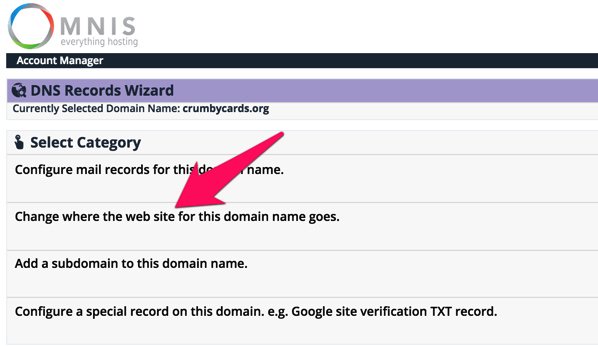
Now let's get started. To begin, we need to load the WordPress application onto your server:
cd /root mkdir wordpress cd wordpress wget http://wordpress.org/latest.tar.gz tar -xvzf latest.tar.gz -C /var/www/html
Next, we'll configure MySQL to support WordPress. We're assuming that you have NOT already created root passwords for MySQL. If you have, you'll need to add -pYourPassword to the various commands below immediately after root. There is no space between -p and your root password. Also edit the first line and make up a new password (replacing XYZ below) for the wordpress user account that will manage WordPress on your server before you cut and paste the code:
mysql -u root -e 'CREATE USER wordpress@localhost IDENTIFIED BY "XYZ";' mysql -u root -e 'CREATE DATABASE wordpress;' mysql -u root -e 'GRANT ALL ON wordpress.* TO wordpress@localhost;' mysql -u root -e 'FLUSH PRIVILEGES;'
Next, we need to configure WordPress with your new MySQL credentials. Before you cut and paste, replace XYZ in the fourth line with the password you assigned in the preceding MySQL step:
cp /var/www/html/wordpress/wp-config-sample.php /var/www/html/wordpress/wp-config.php sed -i 's|database_name_here|wordpress|' /var/www/html/wordpress/wp-config.php sed -i 's|username_here|wordpress|' /var/www/html/wordpress/wp-config.php sed -i 's|password_here|XYZ|' /var/www/html/wordpress/wp-config.php chown -R apache:apache /var/www/html/wordpress
Before you forget, take a moment and create a very secure password for your MySQL root user accounts. Here are the commands. Just replace new-password with your new password before you cut and paste. Note that you also will be prompted for this password when you execute the second command because you will now have a root user password in place from executing the first command.
/usr/bin/mysqladmin -u root password 'new-password' /usr/bin/mysqladmin -u root -p -h localhost.localdomain password 'new-password'
Finally, we need to modify your Apache web server to support WordPress as the primary application. Be sure to enter your actual email address in the third line before you cut and paste the code below:
echo " " >> /etc/httpd/conf/httpd.conf echo "" >> /etc/httpd/conf/httpd.conf echo 'ServerAdmin somebody@somedomain.com' >> /etc/httpd/conf/httpd.conf echo "DocumentRoot /var/www/html/wordpress" >> /etc/httpd/conf/httpd.conf echo "ServerName wordpress" >> /etc/httpd/conf/httpd.conf echo "ErrorLog /var/log/httpd/wordpress-error-log" >> /etc/httpd/conf/httpd.conf echo "CustomLog /var/log/httpd/wordpress-acces-log common" >> /etc/httpd/conf/httpd.conf echo " " >> /etc/httpd/conf/httpd.conf echo " " >> /etc/httpd/conf/httpd.conf service httpd restart
That should do it. Open a browser and navigate to the IP address of your server. You should be greeted with the following form. Fill in the blanks as desired. The account you're setting up will be the credentials you use to add and modify content on your WordPress site when you click Log In (as shown above). Make the username obscure and the password even more so. Remember, it's a public web site accessible worldwide! When you click Install WordPress, you'll be off to the races.
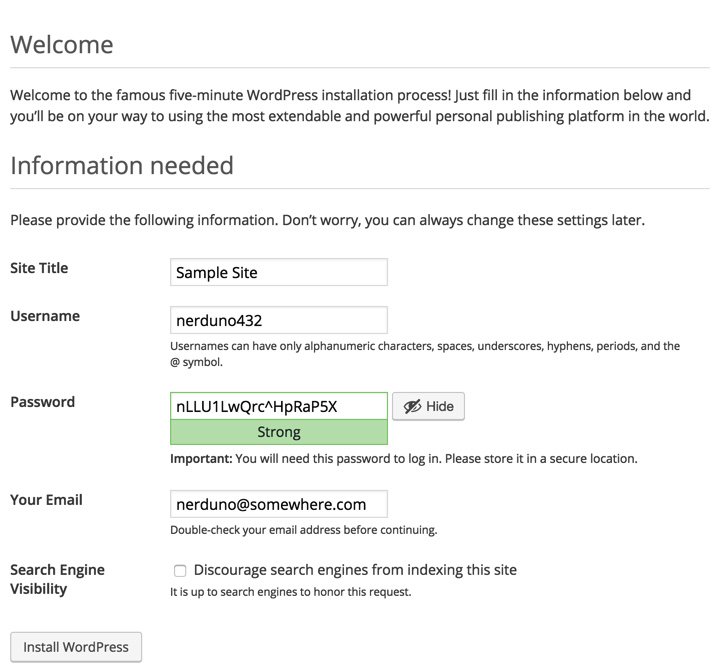
After your server whirs away for a minute or two, you will be greeted with the WordPress login prompt. With the username and password you entered above, you'll be ready to start configuring your WordPress site.
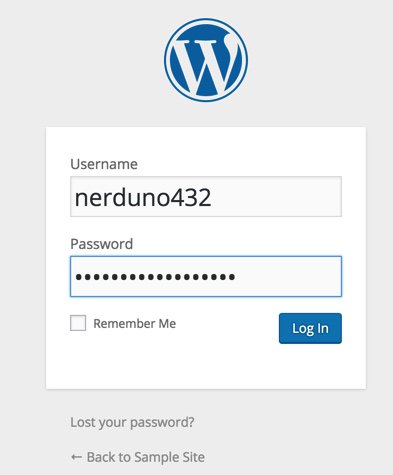
Once you're logged in, navigate to Appearance -> Themes and click Add New Theme. There's you will find literally hundreds of free WordPress templates that can be installed in a matter of seconds if WPZOOM is too rich for your blood. For a terrific all-purpose (free) theme, try Atahualpa. We'll leave our actual demo site running for a bit in case you want to explore and check out its performance. Installing and configuring the new theme took less than a minute:

A Final Word to the Wise. WordPress is relatively secure but new vulnerabilities are discovered regularly. Keep your templates, plug-ins, AND the WordPress application up to date at all times! The WordFence plug-in is a must-have. And we strongly recommend adding the following lines to your WordPress config file which then will let WordPress update everything automatically. Microsoft has given automatic updates a bad name, but in the case of WordPress, they work well.
echo "define('WP_AUTO_UPDATE_CORE', true);" >> /var/www/html/wordpress/wp-config.php
echo "add_filter( 'auto_update_plugin', '__return_true' );" >> /var/www/html/wordpress/wp-config.php
echo "add_filter( 'auto_update_theme', '__return_true' );" >> /var/www/html/wordpress/wp-config.php

Building a 3CX Server in the Cloud
Now we're ready for our second cloud project. In less than 10 minutes, we're going to build a free 3CX commercial PBX using the remaining Cloud resources from our $35 purchase. To create your second virtual machine, click on the CLOUDPRO button in the CloudAtCost control panel and then click Add New Server. Choose 1 CPU, 512MB RAM, and 10GB storage for your second server. Choose Debian 8 64bit as the OS Type and click Complete.
Obtain a free license key for 3CX. Next, log in to your new Debian server as root using SSH or Putty and issue these commands. We'll begin by changing your root password.
NOTE: What appears as the fourth line below needs to be added to line #3!
passwd wget -O- http://downloads.3cx.com/downloads/3cxpbx/public.key | apt-key add - echo "deb http://downloads.3cx.com/downloads/3cxpbx/ /" | tee /etc/apt/sources.list.d/3cxpbx.list apt-get update rm -f /zang-debian.sh apt-get -y install 3cxpbx apt-get -y install sendmail sendmail-bin
When the initial setup finishes, choose the Web Interface Wizard and complete the install using your favorite web browser. Enter your 3CX license key when prompted. Make up a very secure Username and Password to access your 3CX portal. Specify that your IP address is Dynamic when prompted (even though it isn't). This tells 3CX to generate an FQDN for your server. Accept the default ports for HTTP (5000) and HTTPS (5001) access to your server. We recommend choosing 4-digit extensions numbers so you'll be ready for next week's project interconnecting your 3CX server to a Raspberry Pi for the best of both worlds. While logged into the 3CX management portal, adjust Settings → Email to Mail Server → 127.0.0.1 and Reply to → noreply@YourActual3CX-FQDN. Leave the other settings blank and click TEST then OK. Set up a SIP trunk with inbound and outbound call routes. Now download your favorite 3CX smartphone client, send yourself the Welcome Email for your default extension, and start calling. It really doesn't get much easier in the VoIP World. Come join the PIAF Forum if you need a helping hand!
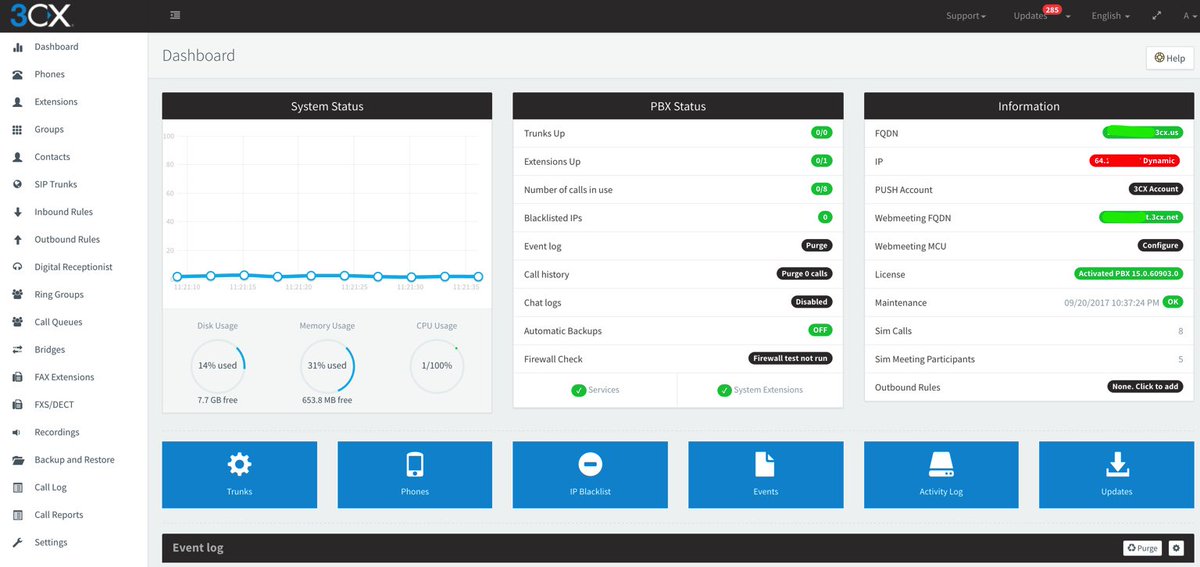
Free Calling in the U.S. and Canada with PIAF5. We know our more frugal U.S. residents are wondering if there's a way to make free calls even with 3CX. You didn't really think there would be a release of PBX in a Flash without Google Voice support, did you? It's easy using the Simonics SIP to Google Voice gateway service. Setup time is about a minute, and the one-time cost is $4.99 using this Nerd Vittles link. Setup instructions for the 3CX side are straight-forward as well, and we've documented the procedure on the PIAF Forum.

Free Calling Worldwide with SIP URIs. There's another free calling option as well. PIAF5 and 3CX support worldwide SIP URI calling at no cost. As part of the PIAF5 install procedure, 3CX registers an FQDN for you with one of the 3CX domains if you indicate that your server has a dynamic IP address. Unless you really know what you're doing with DNS, it's a good idea to tell 3CX you have a dynamic IP address whether you do or not. Here's why. Once you have an assigned FQDN in the 3CX universe, one very slick feature is the ease with which you can publish a SIP URI address for any or all of your 3CX extensions thereby allowing PIAF5 users to receive calls from any SIP client worldwide at no cost. Setup takes less than a minute. It's as easy as 1-2-3. Here's how:
1. Login to the 3CX GUI and go to Settings → Network → FQDN. Tick "Allow calls from/to external SIP URIs" and make note of your FQDN, e.g. mypiaf5server.3cx.us. Click OK.
2. For an extension to enable (e.g. 001), go to Extensions → Edit 001 → Options → SIP ID and create any desired SIP URI alias for this extension, e.g. billybob. Click OK.
3. Anyone with a SIP client anywhere worldwide can now call extension 001 using SIP URI: billybob@mypiaf5server.3cx.us.
Special Thanks: Our special tip of the hat goes to a few web sites that we found helpful in putting this article together especially Unixmen and Matt Wilcox & friends and Programming-Review.
Originally published: Tuesday, February 28, 2017
9 Countries Have Never Visited Nerd Vittles. Got a Friend in Any of Them https://t.co/wMfmlhiQ9y #asterisk #freepbx pic.twitter.com/TPFGZbqWB6
— Ward Mundy (@NerdUno) April 22, 2016

Need help with Asterisk? Visit the PBX in a Flash Forum.
Special Thanks to Our Generous Sponsors
FULL DISCLOSURE: ClearlyIP, Skyetel, Vitelity, DigitalOcean, Vultr, VoIP.ms, 3CX, Sangoma, TelecomsXchange and VitalPBX have provided financial support to Nerd Vittles and our open source projects through advertising, referral revenue, and/or merchandise. As an Amazon Associate and Best Buy Affiliate, we also earn from qualifying purchases. We’ve chosen these providers not the other way around. Our decisions are based upon their corporate reputation and the quality of their offerings and pricing. Our recommendations regarding technology are reached without regard to financial compensation except in situations in which comparable products at comparable pricing are available from multiple sources. In this limited case, we support our sponsors because our sponsors support us.
 BOGO Bonaza: Enjoy state-of-the-art VoIP service with a $10 credit and half-price SIP service on up to $500 of Skyetel trunking with free number porting when you fund your Skyetel account. No limits on number of simultaneous calls. Quadruple data center redundancy. $25 monthly minimum spend required. Tutorial and sign up details are here.
BOGO Bonaza: Enjoy state-of-the-art VoIP service with a $10 credit and half-price SIP service on up to $500 of Skyetel trunking with free number porting when you fund your Skyetel account. No limits on number of simultaneous calls. Quadruple data center redundancy. $25 monthly minimum spend required. Tutorial and sign up details are here.
 The lynchpin of Incredible PBX 2020 and beyond is ClearlyIP components which bring management of FreePBX modules and SIP phone integration to a level never before available with any other Asterisk distribution. And now you can configure and reconfigure your new Incredible PBX phones from the convenience of the Incredible PBX GUI.
The lynchpin of Incredible PBX 2020 and beyond is ClearlyIP components which bring management of FreePBX modules and SIP phone integration to a level never before available with any other Asterisk distribution. And now you can configure and reconfigure your new Incredible PBX phones from the convenience of the Incredible PBX GUI.
 VitalPBX is perhaps the fastest-growing PBX offering based upon Asterisk with an installed presence in more than 100 countries worldwide. VitalPBX has generously provided a customized White Label version of Incredible PBX tailored for use with all Incredible PBX and VitalPBX custom applications. Follow this link for a free test drive!
VitalPBX is perhaps the fastest-growing PBX offering based upon Asterisk with an installed presence in more than 100 countries worldwide. VitalPBX has generously provided a customized White Label version of Incredible PBX tailored for use with all Incredible PBX and VitalPBX custom applications. Follow this link for a free test drive!
 Special Thanks to Vitelity. Vitelity is now Voyant Communications and has halted new registrations for the time being. Our special thanks to Vitelity for their unwavering financial support over many years and to the many Nerd Vittles readers who continue to enjoy the benefits of their service offerings. We will keep everyone posted on further developments.
Special Thanks to Vitelity. Vitelity is now Voyant Communications and has halted new registrations for the time being. Our special thanks to Vitelity for their unwavering financial support over many years and to the many Nerd Vittles readers who continue to enjoy the benefits of their service offerings. We will keep everyone posted on further developments.
Some Recent Nerd Vittles Articles of Interest...
- Should you ever have to migrate your WordPress site from one domain to another, here are two helpful tools to consider: the Automatic Domain Name Changer Plugin and our favorite: WordPress-Domain-Changer. [↩]
2016, The Year of VoIP Choice: Introducing Ombutel
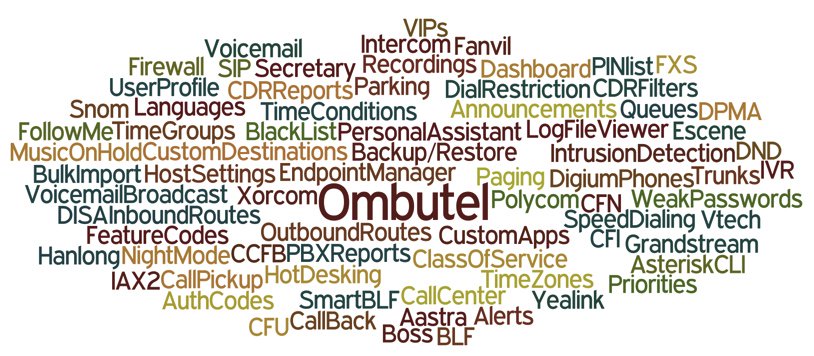
Today we’re pleased to introduce our last (but not least) Unified Communications platform for 2016. Meet Ombutel, a terrific new GUI-based Asterisk® aggregation that was developed jointly by Telesoft and Xorcom, two familiar faces in the Asterisk community. We racked our brain trying to come up with a simple way to explain all of the things that Ombutel can do. We finally concluded "a picture [really] is worth a thousand words!"
Here’s some additional background on the Ombutel project:
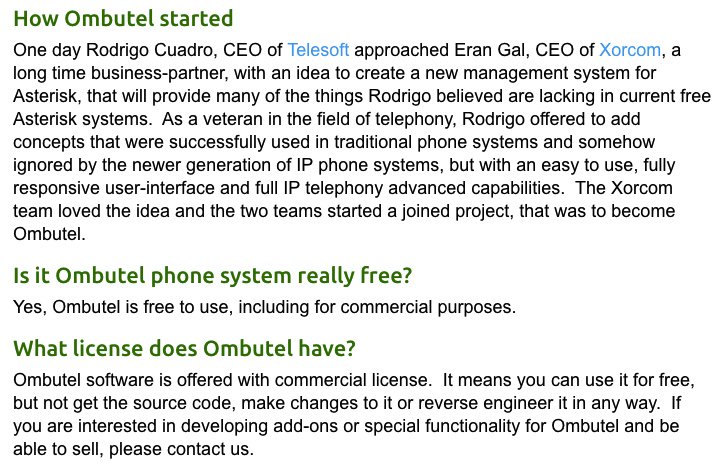
As with the other platforms we’ve introduced this year, we think the best way to get started is to install it yourself and kick the tires. For those familiar with FreePBX® or XiVO®, this will be a walk in the park. You set up an Extension and Device, configure a SIP Trunk to handle your calls, define an Inbound and Outbound Route to direct calls to their proper destination, load your extension credentials into a softphone or SIP phone, and you’re done. We were making calls after loading Ombutel into VirtualBox in less than 30 minutes.
To get started, download Ombutel from their web site. The ISO is approximately 1GB in size.
Installing Ombutel. Using the console interface in VirtualBox, we kicked off the install and went through the typical CentOS 7 setup choosing a language, choosing a keyboard, selecting an install destination, and setting up a root password. When the base install completes, you can log in as root to obtain Ombutel’s IP address. All of the remaining setup is completed using a browser pointed to Ombutel’s IP address. Set up an admin password for your server. Then login as admin with your new password. The Dashboard will display.
Creating an Extension. To get started, create an Extension and let Ombutel automatically populate an associated Device: (1) PBX → (2) Extensions → (3) Extensions. The only required entries are the (4) Extension Number and (5) Name. Be sure to set the NAT entry correctly for your network. Once you’ve completed the entries, click the Save button and then the red Reload icon. Notice the list icon in the right column of the window. Clicking on the List pull-down will show all of the extensions you created and allow you to edit them and decipher whether a particular extension is active.
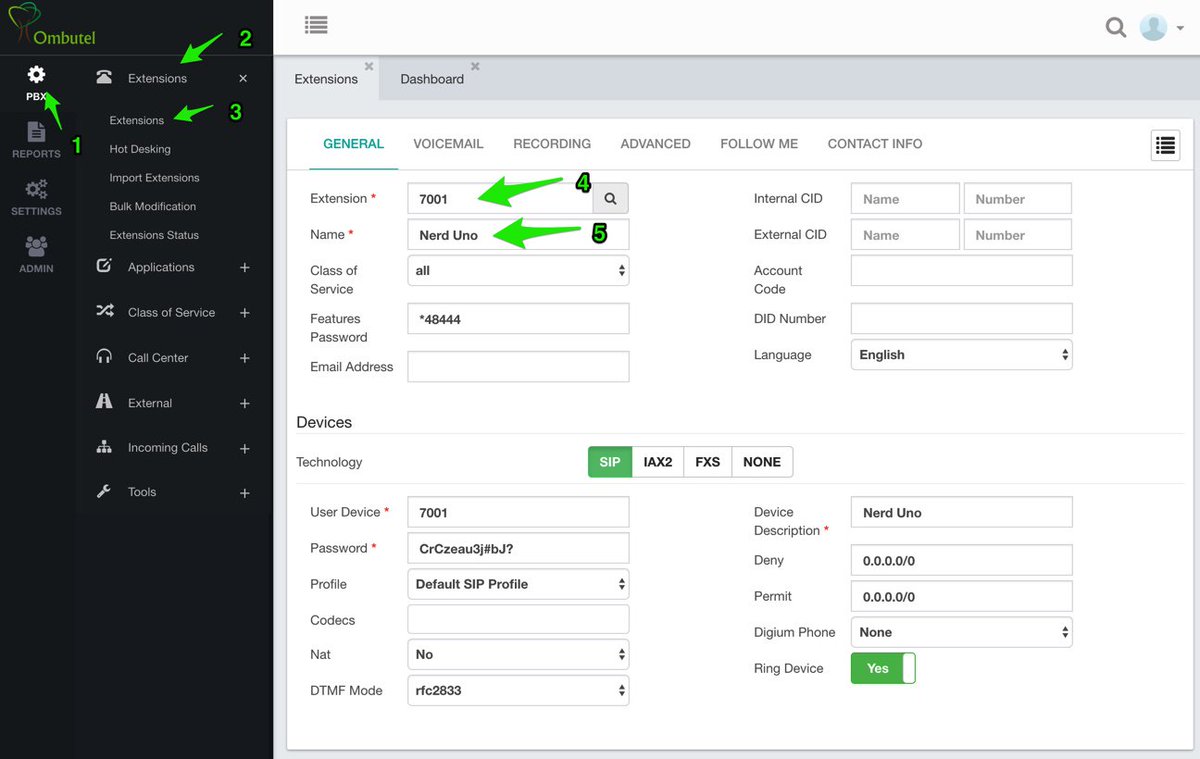
Adding a SIP Trunk. Adding Trunks is equally straight-forward: (1) PBX → (2) External → (3) Trunks. Then fill in the dozen items with your own credentials and settings. We’ve used a RingPlus SIP trunk as an example. NOTE: Be sure to set the From User field to your 10-digit RingPlus number even though this is not shown in the screenshot below. Once you’ve completed the entries, click the Save button and then the red Reload icon. As previously noted, the list icon in the right column will display all of the Trunks you’ve created.
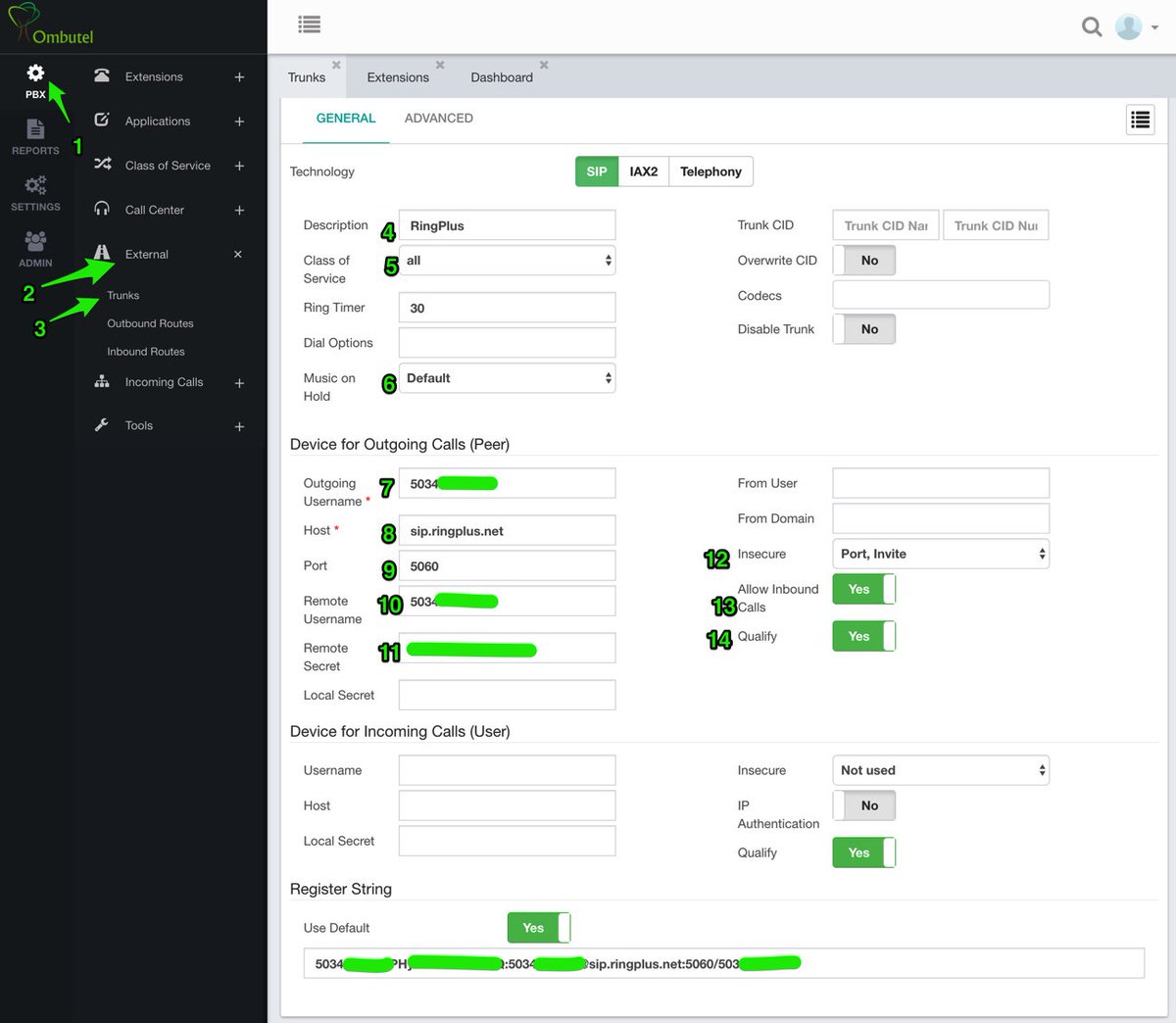
Configuring an Incoming Route. As with other PBXs, incoming routes define how calls from individual DIDs are routed once they arrive. The minimum requirements to set up an Incoming Route are a Description, a DID Pattern (usually the number associated with the DID), and a Destination for the incoming calls. Once you’ve completed the entries, click the Save button and then the red Reload icon. As previously noted, the list icon in the right column will display all of the Incoming Routes you’ve created and let you edit them.
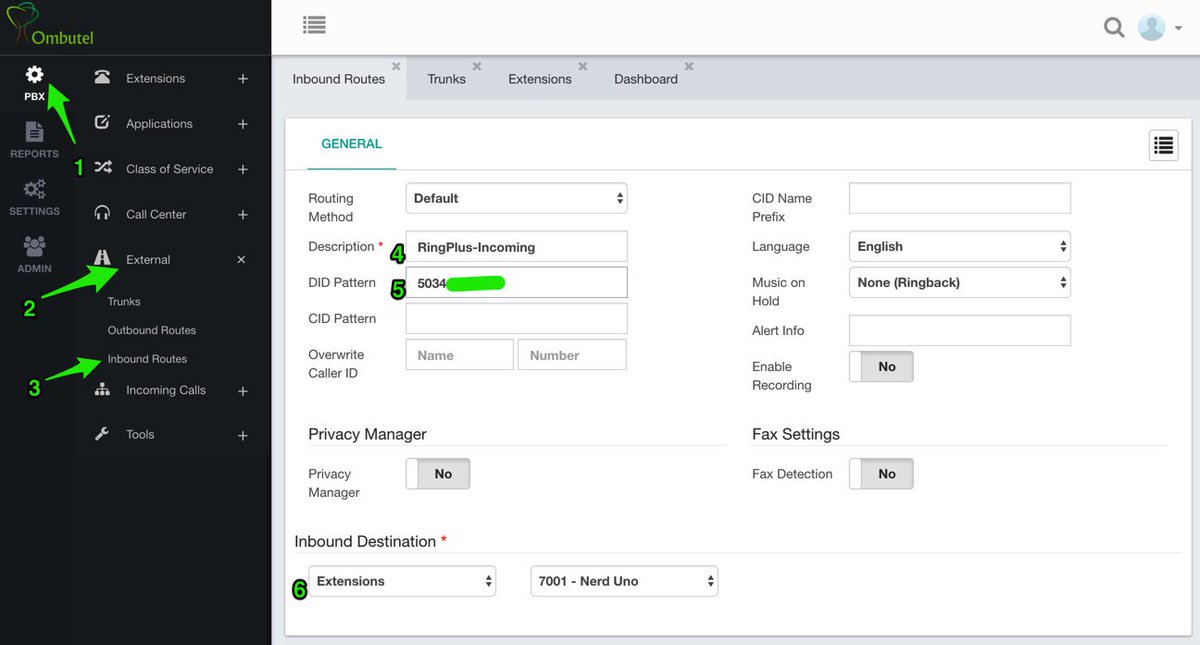
Configuring an Outgoing Route. As with other PBXs, outbound routes define how calls are routed out of your PBX based upon the dial string. You can choose one ore more trunks to associate with each Outbound Route. The dial string for each outbound route needs to be unique. Once you’ve completed the entries, click Save and then the red Reload icon.
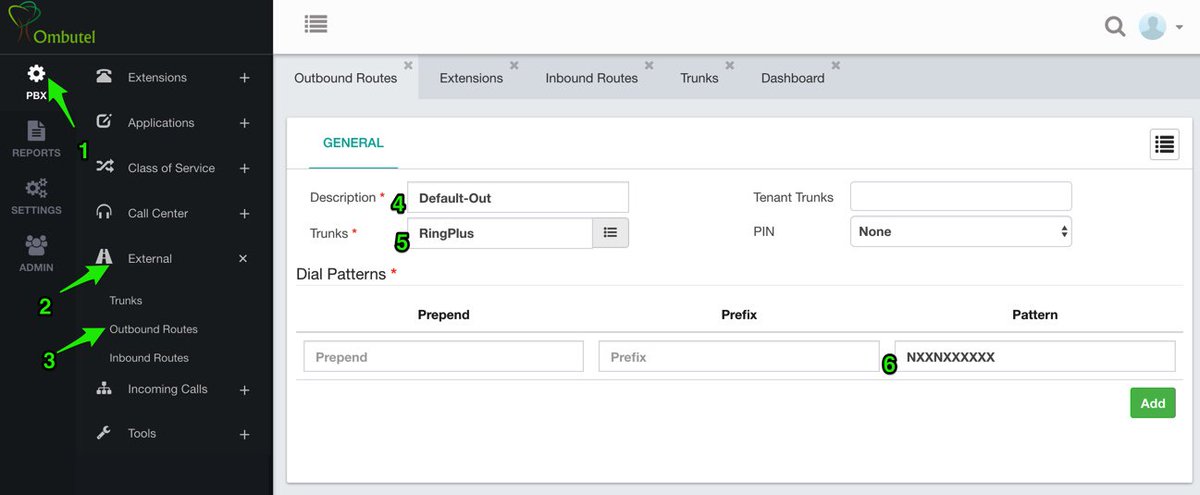
Just to Be Safe, Restart Asterisk. Ombutel still is fairly new code. We’ve found that a quirk occurs once in a while during all of the initial configuration. This typically can be squared away (e.g. extensions not connecting) by restarting Asterisk: /etc/init.d/asterisk restart.
Setting Up a Softphone to Connect to Ombutel. If you’re a Mac user, you’re lucky (and smart). Download and install Telephone from the Mac App Store. Start up the application and choose Telephone:Preference:Accounts. Click on the + icon to add a new account. To set up your softphone, you need 3 pieces of information: the IP address of your server (Domain), and your Username and Password. With Ombutel, choose PBX → Extensions → Extensions. Then click on the List icon and click on the extension to which you want to connect. Now copy or cut-and-paste your User Device number into Username and Password into Password on the Accounts dialog of the Telephone app. Click Done when you’re finished, and your new softphone will come to life and should show Available. Dial the same extension (7001) to test things out. With Telephone, you can use over two dozen soft phones simultaneously on your desktop.
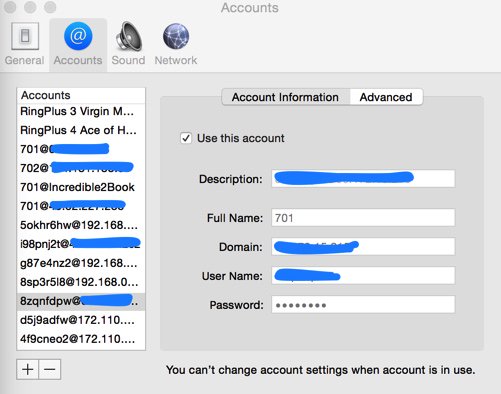
For everyone else, we recommend the YateClient softphone which is free. Download it from here. Run YateClient once you’ve installed it and enter the credentials for the XiVO Line. As with the Telephone app above, you’ll need the IP address of your server plus your User Device and Password associated with the desired extension. Click OK to save your entries.
Some Thoughts on Network Security. We’ll have more to say about the Ombutel security model with FirewallD at another time. Suffice it to say, it’s not our preferred way of securing an Asterisk server. Here’s why. The following ports are all exposed by default:
1 - SIP udp and tcp 5060 2 - DNS tcp and udp 53 3 - NTP udp 123 4 - DHCP udp 67-68 5 - HTTP tcp 80 6 - SSH tcp 22 7 - RTP udp 10000-20000 8 - IAX2 udp 4569 9 - SwitchBoard tcp 4445 10 - mDNS udp 5353 224.0.0.251
You can check these for yourself in /etc/firewalld/services, and you can list the default firewall setup like this: firewall-cmd --list-all-zones. In fairness to Ombutel, their firewall design is no worse than what you will find with AsteriskNOW or the FreePBX Distro or Elastix. Incredible PBX and PBX in a Flash powered by 3CX take a different approach and don’t put all the responsibility for network security on the system administrator. We simply don’t have sufficient confidence in any Asterisk platform to risk exposing SIP, IAX2, HTTP, and SSH to the Big Bad Internet. For the time being until we can complete work on Incredible PBX for Ombutel, we recommend you run Ombutel behind a hardware-based firewall that does not expose these ports to the Internet for anyone and everyone.
Where To Go From Here. Ombutel has an awesome collection of video tutorials that should be the next stop in your Ombutel adventure. We’ve barely scratched the surface of this powerful platform, and there are still some missing pieces such as Google Voice. For the time being, you can use the Simonics SIP to Google Voice gateway to add this functionality. See this recent tutorial for some hints and a discount coupon.

An Early Stocking Stuffer from Santa. We’ll leave you with a quick tutorial on how to install FLITE so that text-to-speech can be used in your Asterisk custom dialplan.1 In addition, we’re releasing the first of many Incredible PBX components for Ombutel with our Yahoo News application. After installing it, just dial *951 from any extension to listen to the latest Yahoo News Headlines. Both FLITE and the news application are GPL2 open source code. We’ll have more goodies to share with you in coming months.
yum -y upgrade cd /usr/src wget http://incrediblepbx.com/Asterisk-Flite-2.2-rc1-flite1.3.tar.gz tar zxvf Asterisk-Flite* cd Asterisk-Flite* yum -y install gcc asterisk-devel make make install make samples ldconfig /etc/init.d/asterisk restart asterisk -rx "core show application like flite" cd / wget http://incrediblepbx.com/nv-news-ombutel.tar.gz tar zxvf nv-news-ombutel.tar.gz rm -f nv-news-ombutel.tar.gz asterisk -rx "dialplan reload"
A final cautionary note to would-be Ombutel developers. You can’t use Feature Codes such as *951 as Destinations in the Ombutel GUI. Instead, you first will need to create a Custom Application as shown below. Then you can use Custom Applications → Yahoo News as a Destination in components such as IVRs and Inbound Routes. Enjoy!
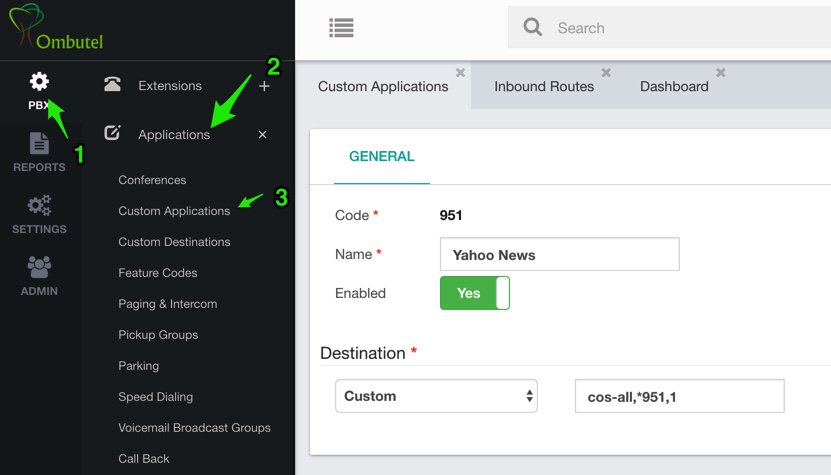
Published: Monday, November 21, 2016

Need help with Asterisk? Visit the PBX in a Flash Forum.
Special Thanks to Our Generous Sponsors
FULL DISCLOSURE: ClearlyIP, Skyetel, Vitelity, DigitalOcean, Vultr, VoIP.ms, 3CX, Sangoma, TelecomsXchange and VitalPBX have provided financial support to Nerd Vittles and our open source projects through advertising, referral revenue, and/or merchandise. As an Amazon Associate and Best Buy Affiliate, we also earn from qualifying purchases. We’ve chosen these providers not the other way around. Our decisions are based upon their corporate reputation and the quality of their offerings and pricing. Our recommendations regarding technology are reached without regard to financial compensation except in situations in which comparable products at comparable pricing are available from multiple sources. In this limited case, we support our sponsors because our sponsors support us.
 BOGO Bonaza: Enjoy state-of-the-art VoIP service with a $10 credit and half-price SIP service on up to $500 of Skyetel trunking with free number porting when you fund your Skyetel account. No limits on number of simultaneous calls. Quadruple data center redundancy. $25 monthly minimum spend required. Tutorial and sign up details are here.
BOGO Bonaza: Enjoy state-of-the-art VoIP service with a $10 credit and half-price SIP service on up to $500 of Skyetel trunking with free number porting when you fund your Skyetel account. No limits on number of simultaneous calls. Quadruple data center redundancy. $25 monthly minimum spend required. Tutorial and sign up details are here.
 The lynchpin of Incredible PBX 2020 and beyond is ClearlyIP components which bring management of FreePBX modules and SIP phone integration to a level never before available with any other Asterisk distribution. And now you can configure and reconfigure your new Incredible PBX phones from the convenience of the Incredible PBX GUI.
The lynchpin of Incredible PBX 2020 and beyond is ClearlyIP components which bring management of FreePBX modules and SIP phone integration to a level never before available with any other Asterisk distribution. And now you can configure and reconfigure your new Incredible PBX phones from the convenience of the Incredible PBX GUI.
 VitalPBX is perhaps the fastest-growing PBX offering based upon Asterisk with an installed presence in more than 100 countries worldwide. VitalPBX has generously provided a customized White Label version of Incredible PBX tailored for use with all Incredible PBX and VitalPBX custom applications. Follow this link for a free test drive!
VitalPBX is perhaps the fastest-growing PBX offering based upon Asterisk with an installed presence in more than 100 countries worldwide. VitalPBX has generously provided a customized White Label version of Incredible PBX tailored for use with all Incredible PBX and VitalPBX custom applications. Follow this link for a free test drive!
 Special Thanks to Vitelity. Vitelity is now Voyant Communications and has halted new registrations for the time being. Our special thanks to Vitelity for their unwavering financial support over many years and to the many Nerd Vittles readers who continue to enjoy the benefits of their service offerings. We will keep everyone posted on further developments.
Special Thanks to Vitelity. Vitelity is now Voyant Communications and has halted new registrations for the time being. Our special thanks to Vitelity for their unwavering financial support over many years and to the many Nerd Vittles readers who continue to enjoy the benefits of their service offerings. We will keep everyone posted on further developments.
Some Recent Nerd Vittles Articles of Interest…
- Customizations to the dialplan can be made by creating files in /etc/asterisk/ombutel with the filename pattern “extensions__NN-*.conf” where NN defines the order in which to load the files. Numbers above 50 are strongly recommended! [↩]
Take the XiVO Plunge: 4 Months of Free Cloud Hosting

Nobody has to tell us how painful change can be. We oversaw the deployment of over 30,000 IBM PCs only to switch horses and become a dedicated Mac lover. And we’ve invested almost 10 years in another Asterisk® GUI only to be disappointed by the direction of that project. That led to our New Year’s Resolution to find a better mousetrap for unified communications open source development. And, boy, did we find one. So here’s the deal. You either believe in the open source community and want to foster free and open development of software, or you don’t. And, if you don’t, that’s perfectly fine. There are lots of commercial PBX alternatives including the terrific 3CX products from our platinum sponsor. But don’t wrap yourself in the open source flag, brag about free and freedom, and then market a product that is none of the above. If your distro’s license agreement prohibits redistribution thereby discouraging sharing which is the lynchpin of the GPL, then the product has little if anything to do with free and freedom.
The good news is we’ve now found an awesome alternative that is pure open source code with an actual GPL3 license. So come join the party and lend a hand with your suggestions and/or your code contributions. We’ll put your name in bright lights, and the open source community will be forever in your debt. Our challenge is to get you as excited about XiVO as we are. There’s nothing with VoIP and Unified Communications that you can’t do better, cheaper, and faster using XiVO. And XiVO’s Asterisk RealTime implementation has no competition, period. Instead of lengthy delays to process changes, rewrite Asterisk config files, and reload the entire Asterisk dial plan, Asterisk RealTime brings instantaneous configuration updates.

We can think of no better way to introduce you to this terrific platform than offering up a free cloud platform until 2017 to let you kick the tires. It won’t impact your production servers while letting you explore the possibilities offered by a state-of-the-art Asterisk 13 platform with no equal. Believe me. We know every wart and pimple in the old GUI platform, and you won’t have to wrestle with any of the traditional problems that we all assumed were native to Asterisk. Guess what? They weren’t. No, your server won’t blow up when you add a new module. No, Asterisk won’t refuse to start because you chose to upgrade an existing component. No, you won’t be Nickle and Dimed into buying critical platform enhancements. And, no, you won’t be charged hundreds of dollars for "support" only to be told that you need to switch to a more proprietary platform. Yes, the XiVO development team releases seamless upgrades every three weeks at no cost. Yes, uncrippled endpoint provisioning for dozens of phones is provided in XiVO at no cost. Yes, powerful call center and High Availability technology is included at no cost. And, yes, backups of your server are made every night for free.
There’s more good news. VULTR is a relatively new cloud provider that now hosts virtual machines in over a dozen cities around the world. For new subscribers, they are offering a $20 credit when you sign up using our referral link. And, yes, your registration provides a few shekels to Nerd Vittles to keep the lights on. The great news is that $20 buys you a full four months of XiVO cloud hosting service, and you won’t find a better do-it-yourself platform at any price, let alone free.
Building the Debian 8 Platform at Vultr for XiVO
The first step in your XiVO adventure is to sign up for a Vultr account with your $20 credit using the Nerd Vittles referral link. Once you’ve done that, it’s time to build your Debian 8 virtual machine to host XiVO in the Cloud. (1) Choose your favorite city to host your server, (2) pick the Debian 8 64-bit platform, and (3) choose the $5/month server size.
IMPORTANT: Leave the Server Hostname & Label blank!
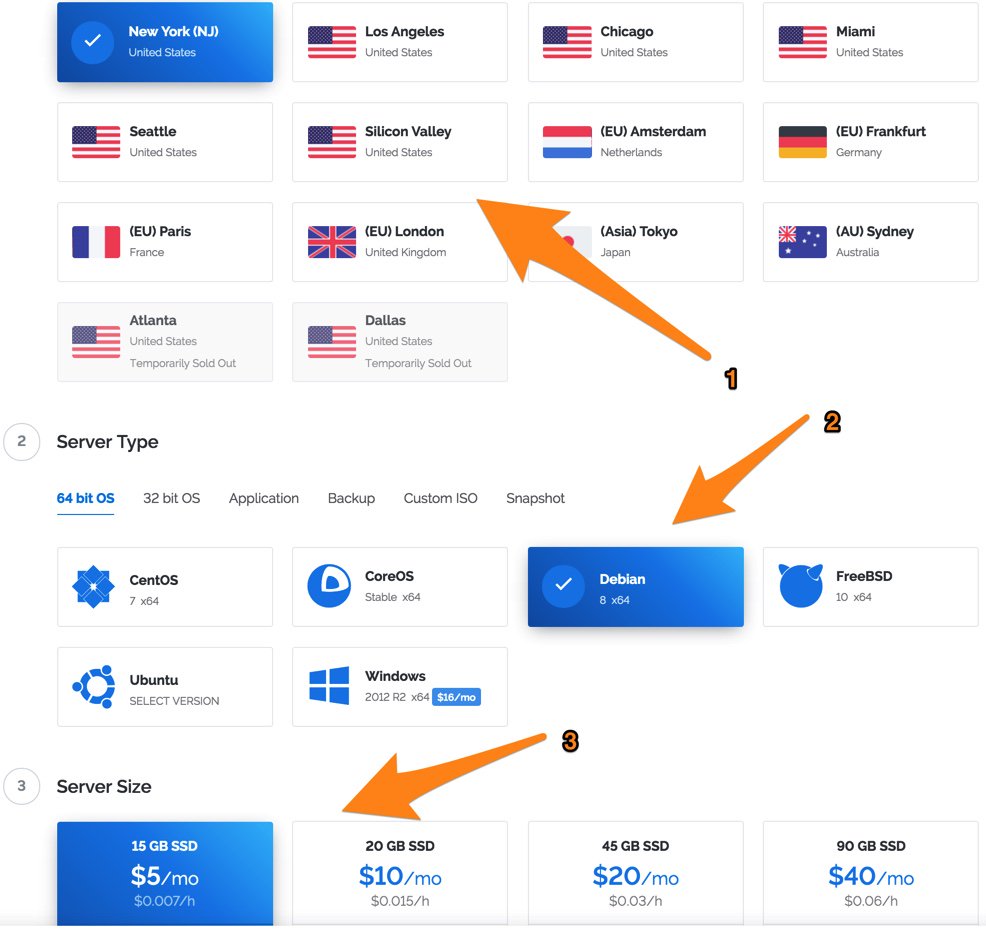
Once your virtual machine is up and running, log in with SSH or Putty using the root password provided. Do NOT install XiVO from the console, or the firewall will lock you out of your own machine! Change your root password immediately: passwd.
Next, set up a swap file on your virtual machine, or the XiVO install will fail on the $5 platform:
dd if=/dev/zero of=/swapfile bs=1024 count=1024k chown root:root /swapfile chmod 0600 /swapfile mkswap /swapfile swapon /swapfile echo "/swapfile swap swap defaults 0 0" >> /etc/fstab sysctl vm.swappiness=10 echo vm.swappiness=10 >> /etc/sysctl.conf free -h cat /proc/sys/vm/swappiness
Installing Incredible PBX for XiVO in the Vultr Cloud
While still logged into your server as root using SSH/Putty, issue the following commands to kick off the install:
cd /root wget http://incrediblepbx.com/IncrediblePBX13-XiVO.sh chmod +x IncrediblePBX13-XiVO.sh ./IncrediblePBX13-XiVO.sh
The initial setup brings your Debian 8 server up to current specs, and then the virtual machine will reboot. After rebooting, log into your server again as root with your new root password. Issue the following command to complete the XiVO and Incredible PBX installation and configuration:
./IncrediblePBX13-XiVO.sh
You’ll be prompted to set your time zone, passwords, and choose the optional features of Incredible PBX you wish to install. We strongly recommend you install ALL of the Incredible PBX feature set. Many cannot be added later.
Verify that the XiVO install completed successfully when prompted. Then verify that the XiVO initial configuration completed successfully by once again pressing ENTER. The firewall and Incredible PBX install will then proceed without further prompting. Total setup time: under 10 minutes.
There still are some setup steps required, and these are performed within the XiVO GUI using a web browser. For step-by-step instructions on the Incredible PBX Initial Configuration Procedure, click here. Enjoy your adventure!
Originally published: Monday, July 25, 2016
9 Countries Have Never Visited Nerd Vittles. Got a Friend in Any of Them https://t.co/wMfmlhiQ9y #asterisk #freepbx pic.twitter.com/TPFGZbqWB6
— Ward Mundy (@NerdUno) April 22, 2016

Need help with Asterisk? Visit the PBX in a Flash Forum.
Special Thanks to Our Generous Sponsors
FULL DISCLOSURE: ClearlyIP, Skyetel, Vitelity, DigitalOcean, Vultr, VoIP.ms, 3CX, Sangoma, TelecomsXchange and VitalPBX have provided financial support to Nerd Vittles and our open source projects through advertising, referral revenue, and/or merchandise. As an Amazon Associate and Best Buy Affiliate, we also earn from qualifying purchases. We’ve chosen these providers not the other way around. Our decisions are based upon their corporate reputation and the quality of their offerings and pricing. Our recommendations regarding technology are reached without regard to financial compensation except in situations in which comparable products at comparable pricing are available from multiple sources. In this limited case, we support our sponsors because our sponsors support us.
 BOGO Bonaza: Enjoy state-of-the-art VoIP service with a $10 credit and half-price SIP service on up to $500 of Skyetel trunking with free number porting when you fund your Skyetel account. No limits on number of simultaneous calls. Quadruple data center redundancy. $25 monthly minimum spend required. Tutorial and sign up details are here.
BOGO Bonaza: Enjoy state-of-the-art VoIP service with a $10 credit and half-price SIP service on up to $500 of Skyetel trunking with free number porting when you fund your Skyetel account. No limits on number of simultaneous calls. Quadruple data center redundancy. $25 monthly minimum spend required. Tutorial and sign up details are here.
 The lynchpin of Incredible PBX 2020 and beyond is ClearlyIP components which bring management of FreePBX modules and SIP phone integration to a level never before available with any other Asterisk distribution. And now you can configure and reconfigure your new Incredible PBX phones from the convenience of the Incredible PBX GUI.
The lynchpin of Incredible PBX 2020 and beyond is ClearlyIP components which bring management of FreePBX modules and SIP phone integration to a level never before available with any other Asterisk distribution. And now you can configure and reconfigure your new Incredible PBX phones from the convenience of the Incredible PBX GUI.
 VitalPBX is perhaps the fastest-growing PBX offering based upon Asterisk with an installed presence in more than 100 countries worldwide. VitalPBX has generously provided a customized White Label version of Incredible PBX tailored for use with all Incredible PBX and VitalPBX custom applications. Follow this link for a free test drive!
VitalPBX is perhaps the fastest-growing PBX offering based upon Asterisk with an installed presence in more than 100 countries worldwide. VitalPBX has generously provided a customized White Label version of Incredible PBX tailored for use with all Incredible PBX and VitalPBX custom applications. Follow this link for a free test drive!
 Special Thanks to Vitelity. Vitelity is now Voyant Communications and has halted new registrations for the time being. Our special thanks to Vitelity for their unwavering financial support over many years and to the many Nerd Vittles readers who continue to enjoy the benefits of their service offerings. We will keep everyone posted on further developments.
Special Thanks to Vitelity. Vitelity is now Voyant Communications and has halted new registrations for the time being. Our special thanks to Vitelity for their unwavering financial support over many years and to the many Nerd Vittles readers who continue to enjoy the benefits of their service offerings. We will keep everyone posted on further developments.
Some Recent Nerd Vittles Articles of Interest…
Smartphone Trifecta: 2016’s Very Best Cellphones with Two Awesome Surprises

Every year we try to check out the latest and greatest smartphones with emphasis on finding those that are the best fit with Asterisk®. So this year is really special because our three favorite new phones all come with a couple of surprises. First, monthly cellular service can be FREE on all of them! Second, all of the phone numbers associated with the three phones can be used as free SIP trunks with Incredible PBX™ or your favorite Asterisk server.
If you’ve been following Nerd Vittles since early February of this year, then you already know that RingPlus, a Sprint MVNO, is the best bargain on the planet. Over the past six weeks of weekly specials from RingPlus, we’ve managed to update all of our free RingPlus accounts to either unlimited calling, texting, and 2GB of monthly data or 3,000 minutes of calling, 3,000 text messages, and 3GB of data. For anybody (except teenagers) that’s sufficient monthly capacity to do almost anything you’d like to do with a smartphone except stream movies all day.
We initially showed how to take dirt cheap Boost Mobile and Virgin Mobile prepaid phones and repurpose them for use with RingPlus. Sprint apparently read our article as well because that loophole is going away on April 17. However, you still have time to find one and activate it on RingPlus following our previous tutorial. The only catch is that, if you ever deactivate it, you will lose the ability to reactivate it without first using it with Boost or Virgin for a full year. The landfills will be so happy with all these cellphone bricks because of Sprint’s latest attempt to shoot itself in the foot. We think there also are some legal issues that the FCC needs to address. These phones are sold as "contract-free" when, in fact, there is a very specific and undisclosed contractual requirement. If you don’t keep service with the provider for a year, your phone becomes a brick. In antitrust terminology, it’s called tying. And some would argue that it also constitutes false advertising. We plan to file a complaint and would urge all of our readers to do the same. Here’s a link.
But enough about the Sprint mentality. It really is legendary, and it’s been the same for 20+ years. We doubt it will ever change unless the entire Sprint management team is replaced. So where do we go from here? Well we decided to upgrade most of our phones to the latest and greatest postpaid phones available, and we wanted to try out our 2016 favorites (pictured above). Here’s some really great news. Samsung’s new Galaxy S7 and S7 Edge as well as Apple’s new iPhone SE work swimmingly with RingPlus as long as you purchase the Sprint-branded models at full retail price from either Best Buy or an Apple Store. Sprint and Target will refuse to sell you one unless you activate it with Sprint in the store. You also can’t buy the Sprint-branded iPhones on line from Apple without activating Sprint service, but that restriction doesn’t apply if you visit an Apple Store.
It took a week to chase down a Galaxy S7 and almost two weeks to find a Galaxy S7 Edge at a Best Buy store. Don’t believe the store inventory on their web site. Neither of the phones we purchased was shown as available at the locations where we bought them. So you’ll need to call or visit a store at least while the new Galaxy phones remain a scarce commodity. As for the iPhone SE, it went on sale at Apple Stores this morning at 10 a.m. At the Charleston store, I was third in line and both of the people in front of me also were buying the Sprint-branded iPhone SE to use with RingPlus. The Apple sales folks said they had never before seen a run on Sprint phones. Guess why?

Here’s the drill. Purchase your favorite phone after you read our mini-reviews below. Don’t open the box just yet. Instead, look on the bottom of the box and decipher the IMEI/MEID of your phone. Immediately run that number through the RingPlus Device Checker to be sure it will work on the Sprint network using a RingPlus account. There shouldn’t be a problem with any of these three phones, and all of them come with a Sprint SIM card so you won’t have to worry about obtaining one from RingPlus. Some have reported that the Best Buy phones were locked. We can only surmise that the customer delayed activating the phone with RingPlus which gave Sprint time to block the serial number which Best Buy reported. If this happens to you, we are told that Sprint will unlock the phone once you provide proof that it was purchased at full retail price. If all else fails, Best Buy has a 14-day return policy. Remember, anything is possible when dealing with Sprint.
Once your phone passes the compatibility check, sign up for a new free RingPlus plan. These plans change weekly and sometimes are only offered for a couple of hours so you may want to hold off on signing up until a deal comes along that meets your requirements. Update: There are a number of excellent promotions at the moment which run through April 5. Our previous article explained in detail how these free plans work. Switching plans typically is limited to those that buy into the annual Member+ program. You can read all about the plans and programs on the RingPlus Community Forum. If you already have a RingPlus account with a registered phone, you can swap out the phone with one of these three new ones for a one-time charge of $1.99. All you’ll need is your new MEID and ICC ID numbers. The entire phone swap only takes a minute or two. Once it’s complete, turn on your phone. The rest is automagic!
Comparing the Phones. We don’t often glow about reviews, but the TechRadar review of the Galaxy S7 Edge is a must-read. There has never been a better phone than this one. And, only an inch behind it is the Galaxy S7 which bears an uncanny resemblance to the new iPhone SE except for its 50% larger screen size. We actually are more comfortable carrying the Galaxy S7 with its all-metal construction. For whatever reason, the S7 Edge always feels like its about a millisecond away from slipping out of your hand. You will most definitely want a case for the S7 Edge.
In terms of performance and camera quality, the new Galaxy phones are in a league of their own. Here’s a photo hurriedly snapped through a restaurant window with our Galaxy S7 earlier this week. If you’ve ever tried to take sunset pictures with an iPhone or cheapo Android device, you’ll appreciate what a challenge these shots can be. We’ll annotate this article with an iPhone SE photo if and when the opportunity presents itself. The other good news with the new Galaxy phones is they are at least waterproof for a few minutes. If you live near the water, that will come as a welcome addition as well. Finally, Samsung has closed the gap with Apple’s iPhones on backing up and restoring everything on your phone. For years, this has been Apple’s best feature in our humble opinion. Now Samsung goes Apple one better. If you happen to have two Samsung devices that you want clone, simply choose Backup and Reset from Settings. Then Open Smart Switch on both devices and hold the two phones back to back. It’s that easy. Or you can opt for the more traditional restore method that works precisely as it does with an iPhone using the Samsung Cloud. For some additional tips and tricks, visit the PCMag.com site and watch the video "Exploring the Galaxy S7″ which includes a number of comparisons with Apple iPhone devices including the iPhone SE. Enjoy!

We previously covered the SIP setup for RingPlus devices using their WiFi Fluidcall feature. It provides a free SIP trunk for Asterisk at a cost of zero dollars. For the complete tutorial, take a look at the original article. Enjoy!
Originally published: Thursday, March 31, 2016
9 Countries Have Never Visited Nerd Vittles. Got a Friend in Any of Them https://t.co/wMfmlhiQ9y #asterisk #freepbx pic.twitter.com/TPFGZbqWB6
— Ward Mundy (@NerdUno) April 22, 2016

Need help with Asterisk? Visit the PBX in a Flash Forum.
Special Thanks to Our Generous Sponsors
FULL DISCLOSURE: ClearlyIP, Skyetel, Vitelity, DigitalOcean, Vultr, VoIP.ms, 3CX, Sangoma, TelecomsXchange and VitalPBX have provided financial support to Nerd Vittles and our open source projects through advertising, referral revenue, and/or merchandise. As an Amazon Associate and Best Buy Affiliate, we also earn from qualifying purchases. We’ve chosen these providers not the other way around. Our decisions are based upon their corporate reputation and the quality of their offerings and pricing. Our recommendations regarding technology are reached without regard to financial compensation except in situations in which comparable products at comparable pricing are available from multiple sources. In this limited case, we support our sponsors because our sponsors support us.
 BOGO Bonaza: Enjoy state-of-the-art VoIP service with a $10 credit and half-price SIP service on up to $500 of Skyetel trunking with free number porting when you fund your Skyetel account. No limits on number of simultaneous calls. Quadruple data center redundancy. $25 monthly minimum spend required. Tutorial and sign up details are here.
BOGO Bonaza: Enjoy state-of-the-art VoIP service with a $10 credit and half-price SIP service on up to $500 of Skyetel trunking with free number porting when you fund your Skyetel account. No limits on number of simultaneous calls. Quadruple data center redundancy. $25 monthly minimum spend required. Tutorial and sign up details are here.
 The lynchpin of Incredible PBX 2020 and beyond is ClearlyIP components which bring management of FreePBX modules and SIP phone integration to a level never before available with any other Asterisk distribution. And now you can configure and reconfigure your new Incredible PBX phones from the convenience of the Incredible PBX GUI.
The lynchpin of Incredible PBX 2020 and beyond is ClearlyIP components which bring management of FreePBX modules and SIP phone integration to a level never before available with any other Asterisk distribution. And now you can configure and reconfigure your new Incredible PBX phones from the convenience of the Incredible PBX GUI.
 VitalPBX is perhaps the fastest-growing PBX offering based upon Asterisk with an installed presence in more than 100 countries worldwide. VitalPBX has generously provided a customized White Label version of Incredible PBX tailored for use with all Incredible PBX and VitalPBX custom applications. Follow this link for a free test drive!
VitalPBX is perhaps the fastest-growing PBX offering based upon Asterisk with an installed presence in more than 100 countries worldwide. VitalPBX has generously provided a customized White Label version of Incredible PBX tailored for use with all Incredible PBX and VitalPBX custom applications. Follow this link for a free test drive!
 Special Thanks to Vitelity. Vitelity is now Voyant Communications and has halted new registrations for the time being. Our special thanks to Vitelity for their unwavering financial support over many years and to the many Nerd Vittles readers who continue to enjoy the benefits of their service offerings. We will keep everyone posted on further developments.
Special Thanks to Vitelity. Vitelity is now Voyant Communications and has halted new registrations for the time being. Our special thanks to Vitelity for their unwavering financial support over many years and to the many Nerd Vittles readers who continue to enjoy the benefits of their service offerings. We will keep everyone posted on further developments.
Some Recent Nerd Vittles Articles of Interest…
It’s Back: $10.50 Buys an Incredible PBX in the Cloud For Life… If You Hurry
In January, we began our new series on Cloud Computing by documenting how to build an awesome LAMP server in the Cloud using Linux. Today we’re again going to show you how to use the same Cloud platform and take advantage of the $10.50 coupon code TAKE70 to build an Incredible PBX in the Cloud FOR LIFE. When you’re finished, you’ll have a state-of-the-art Incredible PBX 13 server with hundreds of PBX features including free calling to the U.S. and Canada using any (free) Google Voice account. Keep in mind this isn’t $10.50 a month for your cloud server. It’s $10.50, period! The whole project takes less than an hour. Before we begin, let’s revisit our cautionary note for those that missed it in the previous article. It’s important.
There’s lots to hate at Cloud At Cost, a Canadian provider that offers virtual machines in the cloud for a one-time fee with no recurring charges. For
$35$10.50, you get a virtual machine with 512MB of RAM, 10GB of storage, and a gigabit Internet connection FOR LIFE. We haven’t seen a week go by when Cloud at Cost didn’t offer some sort of discount. Today it’s 70% which brings the total cost down to $10.50. That’s less than a burger at Five Guys. That’s the good news. But, if security, 99.999% reliability, performance, and excellent customer support are your must-haves, then look elsewhere. So why would anyone in their right mind sign up for a cloud solution that didn’t offer those four things? Did we mention it’s $10.50 for a lifetime cloud server?If you take our recommendation and plunk down your $10.50, you’ll need to go into this with the right attitude. It’s not going to be flawless perfection computing. It’s a sandbox on which to experiment with [VoIP] and Cloud Computing. Will your virtual machine disintegrate at some juncture? Probably. Our experience is that the first couple days are critical. If you start seeing sluggish performance which degenerates to zero, don’t waste your time. Take good notes as you go along, delete the virtual machine, and rebuild a new one. It won’t cost you a dime, and it’ll save you hours of frustration. We suspect that bad folks get onto some of the servers and delight in bringing the machines to their knees. So the quicker you cut your losses, the better off you will be. Is CloudAtCost a good solution for production use?
AbsolutelyProbably not so don’t try to fit a square peg in the round hole. It’s not gonna work, and you WILL be disappointed.
Today’s experiment will give you a platform on which to learn before you decide upon a more permanent deployment solution. And it will give you a terrific home for a backup server once you do move to a long-term solution so your $10.50 won’t be wasted.
TAKE70: Build a VoIP Server in the Cloud FOR LIFE w/ Free US/CAN calling https://t.co/l9It2xq14S #asterisk #freepbx pic.twitter.com/UYuCMcfEn8
— Ward Mundy (@NerdUno) January 31, 2016
The objective today is to show you how to build a rock-solid, secure VoIP server in the Cloud with all the bells and whistles you’d typically find on a PBX costing tens of thousands of dollars. Incredible PBX is pure GPL, open source code with one major difference. It’s FREE! And it’s supported by thousands of users on the PIAF Forum that started just like you.
Some of you are probably wondering why you would want a PBX at all. Hearing is believing as they say. Spend a couple minutes and call our CloudAtCost demo server. We preconfigured it using everything provided in today’s tutorial. It’ll let you play with some of the features that a PBX offers such a voice dialing from a directory, news and weather forecasts, and much more. And, in case you’re wondering, it’s been running 24/7 for two full months without a single hiccup. To try it for yourself, just dial: 
Nerd Vittles Demo IVR Options
1 – Call by Name (say “Delta Airlines” or “American Airlines” to try it out)
2 – MeetMe Conference (password is 1234)
3 – Wolfram Alpha (say “What planes are flying overhead now?”)
4 – Lenny (The Telemarketer’s Worst Nightmare)
5 – Today’s News Headlines
6 – Weather Forecast (Just enter your ZIP Code!)
7 – Today in History
8 – Speak to a Real Person (or maybe just voicemail if we’re out)
For long time readers of Nerd Vittles, you already know that the component we continually stress is security. Without that, the rest really doesn’t matter. You’ll be building a platform for someone else to hijack and use for nefarious purposes. When we’re finished today, you’ll have a cloud-based VoIP server that is totally invisible to the rest of the world except a short list of VoIP providers that have been thoroughly vetted by Nerd Vittles staff. You can whitelist additional locations and phones to meet your individual needs without worrying about your server being compromised.
Creating Your Virtual Machine Platform in the Cloud
To get started, you’ve got to cough up your $10.50 at Cloud at Cost using coupon code TAKE70. Once you’ve signed up, CloudAtCost will send you credentials to log into the Cloud at Cost Management Portal. Change your portal password IMMEDIATELY after logging in. Just go to SETTINGS and follow your nose. HINT: DC2 is the preferred data center!

To create your virtual machine, click on the CLOUDPRO button and click Add New Server. If you’ve only purchased the $10.50 CloudPRO 1 platform, then you’ll need all of the available resources shown in the pick list. Leave CentOS 6.7 64bit selected as the OS Type and click Complete. Depending upon the type of special pricing that Cloud at Cost is offering when you sign up, the time to build your virtual machine can take anywhere from a minute to the better part of a day. Things have settled down since the 90% off week so new servers typically are ready in a few minutes. However, we’ve learned to build new virtual machines at night where possible. Then they’re usually available for use by the next morning. Luckily, this slow performance does not impact existing virtual machines that already are running in the CloudAtCost hosting facilities.
Initial Configuration of Your CentOS 6.7 Virtual Machine

With a little luck, your virtual machine soon will appear in your Cloud at Cost Management Portal and look something like what’s shown above. The red arrow points to the i button you’ll need to click to decipher the password for your new virtual machine. You’ll need both your IP address and the password for the new virtual machine in order to log into the server which is now up and running with a barebones CentOS 6.7 operating system. Note the yellow caution flag. That’s telling you that Cloud at Cost will automatically shut down your server in a week to save (them) computing resources. You can change the setting to keep your server running 24/7. Click Modify, Change Run Mode, and select Normal – Leave Powered On. Click Continue and OK to save your new settings.

Finally, you’ll want to change the Host Name for your server to something more descriptive than c7…cloudpro.92… Click the Modify button again and click Rename Server to change it. IncrediblePBX13 has a nice ring to it, but to each his own.
Logging into Your New CentOS 6.7 Virtual Machine
In order to configure and manage your new CentOS 6.7 virtual machine, you’ll need to log into the new server using either SSH or, for Windows users, Putty. After installing Putty, run it and log in to the IP address of your VM with username root and the password you deciphered above. On a Mac, open a Terminal session and issue a command like this using the actual IP address of your new virtual machine:
ssh root@12.34.56.78
Before you do anything else, reset your Virtual Machine’s root password to something very secure: passwd
Next, let’s address a couple of CloudAtCost quirks that may cause problems down the road. CloudAtCost has a nasty habit of not cleaning up after itself with fresh installs. The net result is your root password may get reset every time you reboot even though you changed it.
sed -i '/exit 0/d' /etc/rc.local killall plymouthd echo killall plymouthd >> /etc/rc.local rm -f /etc/rc3.d/S97* echo "exit 0" >> /etc/rc.local
Installing Incredible PBX 13 with CentOS 6.7
Now we’re ready to build your VoIP server platform. There aren’t many steps so just cut-and-paste the code into your SSH or Putty session and review the results to make sure nothing comes unglued. If something does, the beauty of virtual machines is you can delete them instantly within your management portal and just start over whenever you like. So here we go…
We’ll begin by permanently turning off SELINUX which causes more problems than it solves. The first command turns it off instantly. The second line assures that it’ll stay off whenever you reboot your virtual machine.
setenforce 0 sed -i s/SELINUX=enforcing/SELINUX=disabled/g /etc/selinux/config
Now let’s bring CentOS 6.7 up to current specs and add a few important applications:
yum -y update yum -y install net-tools nano wget tar reboot
Once your server reboots, we’re ready to kick off the Incredible PBX 13 install:
cd /root wget http://incrediblepbx.com/incrediblepbx13-12.2-centos.tar.gz tar zxvf incrediblepbx* ./IncrediblePBX*
When the install begins, read the license agreement and press ENTER to agree to the terms and get things rolling. Now would be a great time to go have breakfast or lunch. Come back in about an hour and your server should be ready to go.
Implementing Dynamic DNS Service on Your Client Machines
Unlike some other PBX offerings that leave your server exposed to the Internet, Incredible PBX is different. Unless the IP address from which you are accessing the server has been whitelisted, nobody on the Internet can see your server. The only exception is the preferred providers list and those on the same local area network (which is nobody in the case of CloudAtCost). As part of the Incredible PBX install, the IP address of the computer you used to perform the install was whitelisted automatically. But there may be other computers from which you wish to allow access to the PBX in order to deploy telephones at remote sites. Some of these sites may have dynamic IP addresses that change from time to time. Or you may have traveling salesman that land in a new hotel almost every night with a new IP address. Fortunately, there are a number of free and paid Dynamic DNS providers. For sites with dynamic IP addresses, simply choose a fully-qualified domain name (FQDN) to identify each location where you need computer access or need to deploy a phone. Then run a dynamic DNS update utility periodically from a computer or router at that site. It reports back the current public IP address of the site and your DNS provider updates the IP address assigned to that FQDN whenever there are changes.
DNS update clients are available for Windows, Mac OS X, and many residential routers. They’re also available for Android devices. Then it’s just a matter of plugging in the remote users’ FQDNs so Incredible PBX knows to give them server access via the whitelist. You implement this in seconds using the add-ip and add-fqdn utilities in the /root directory.
There are other ways to gain access as well using the PortKnocker utility or Travelin’ Man 4 from a telephone. Both of these are covered in the Incredible PBX 13 tutorial so we won’t repeat it here.
Incredible PBX Preliminary Setup Steps
First, let’s check things out and make sure everything is working as it should. With your favorite web browser, visit the IP address of your new server. You should see the default Incredible PBX page, the Kennonsoft Menu. It’s divided into two parts, a Users tab (shown below) and an Admin tab with additional options that we’ll cover shortly.
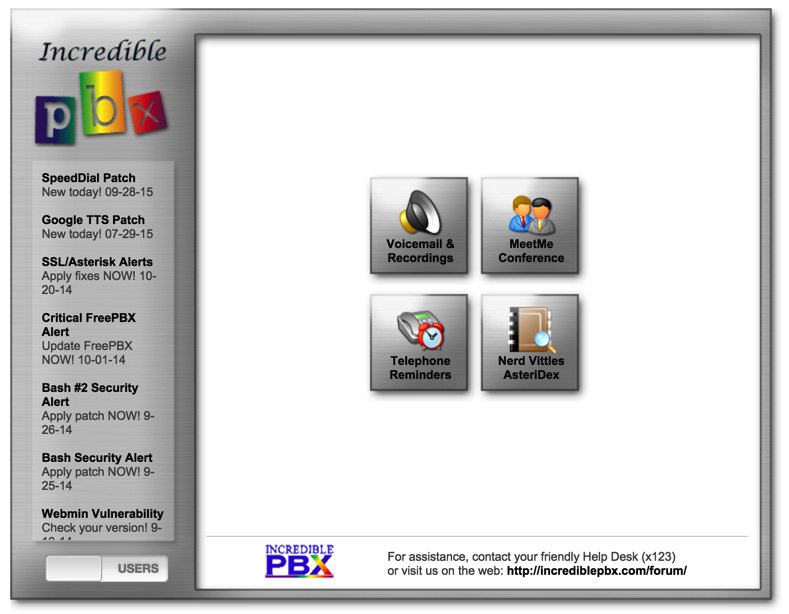
Now we need to jump back to SSH or Putty and log back into your server as root. You’ll note that the Incredible PBX Automatic Update Utility is run each time you log in. This is how important security updates are pushed to your server so do it regularly. And, no, you don’t need to contribute to our open source projects unless you want to. You’ll still get the updates as they are released.
After the Automatic Update Utility runs, the login script will execute status which tells you everything you need to know about the health of your server. After the initial install, it will look something like this with your server’s IP address obviously. We’ll cover the RED items down the road a bit.
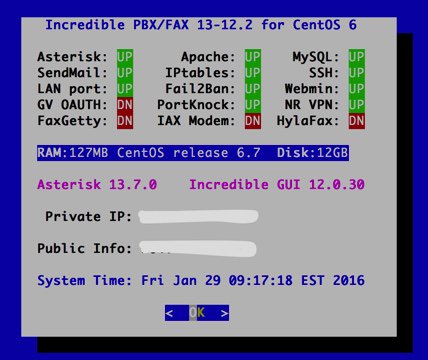
For now, we need to complete a few preliminary setup steps for Incredible PBX to make sure you can log into the various components which have been installed on your computer. There are several different credentials you will need. Most of these are configured using scripts in the /root folder of your server. First, you need your root password for the server itself, and you should have already set that up with a very secure password using passwd. These same credentials are used to login to WebMin.
Next you’ll need an admin password for the Incredible PBX GUI. This is the management utility and Asterisk® code generator which consists of FreePBX® GPL modules that are open source and free to use. The admin password is set by running admin-pw-change in the /root directory.
There are also a number of web-based applications such as Telephone Reminders, AsteriDex, phpMyAdmin, and VoiceMail & Recordings (User Control Panel). You obviously don’t want everyone with a telephone using all of these applications so they are protected using a couple different Apache web server credentials. First, you set up an admin password for the administrator-level applications using the htpasswd utility. Then you set up an end-user account and password for access to AsteriDex, Reminders, and the User Control Panel. With the User Control Panel, end users also will need a username and password for their particular phone extension and this is configured with the Incredible PBX GUI using Admin -> User Management -> Add New User. If this sounds convoluted, it’s really not. Apache credentials can be entered once in an administrator’s or end user’s browser and they’re stored permanently.
Here is a checklist of the preliminary steps to complete before using your server:
Make your root password very secure: passwd
Create admin password for Incredible PBX GUI access: /root/admin-pw-change
Create admin password for web apps: htpasswd /etc/pbx/wwwpasswd admin
Create joeuser password for web apps: htpasswd /etc/pbx/wwwpasswd joeuser
Set up UCP accounts for Voicemail & Recordings access using Incredible PBX GUI
Make a copy of your Knock codes: cat /root/knock.FAQ
Decipher IP address and other info about your server: status
Set your correct time zone: /root/timezone-setup
Activating Incredible Fax on Your Server
Incredible PBX also includes an optional (and free) faxing component that lets you send and receive faxes that are delivered to your email address. To activate Incredible Fax, run the following script and plug in your email address for delivery of incoming faxes: /root/incrediblefax11.sh. After entering your email address, you’ll be prompted for all sorts of additional information. Unless you have unusual requirements, pressing the ENTER key at every prompt is the appropriate response. You’ll need to reboot your server again when the fax installation is complete. Once you log back into your server as root, the bottom line of the status display should now be green UP entries.
Managing Your Server with the Incredible PBX GUI
About 99% of your time managing your server will be spent in the Incredible PBX GUI. To access it, fire up your browser and point to the IP address of your server. At the Kennonsoft menu, click on the Users tab which will change to Admin and bring up the Admin menu shown here:
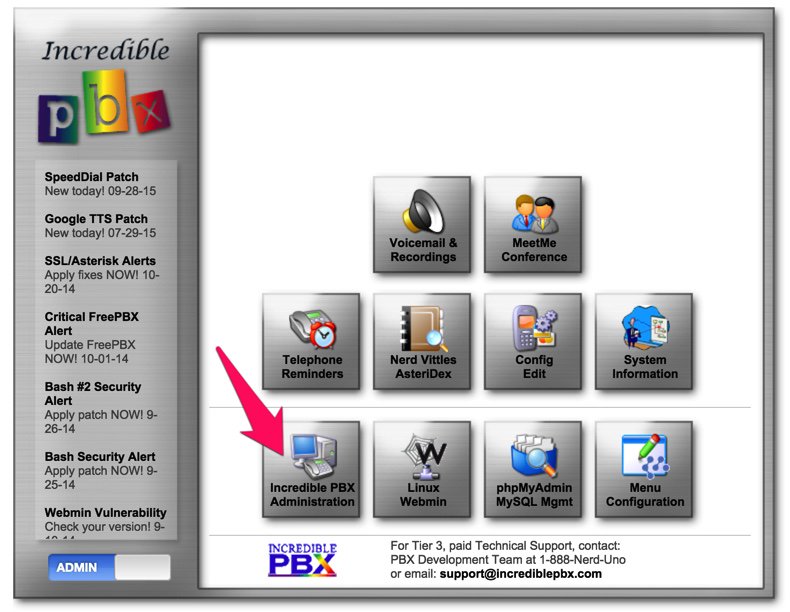
From the Administrator menu in the Kennonsoft GUI, click on Incredible PBX Administration. This will bring up the following menu:
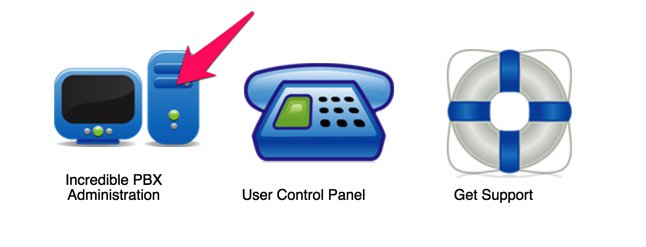
Click on the first icon to access the Incredible PBX GUI. You’ll be prompted for your credentials. For the username, enter admin. For the password, enter the password you set up using admin-pw-change above. You should then be greeted by the main status display in the Incredible GUI:
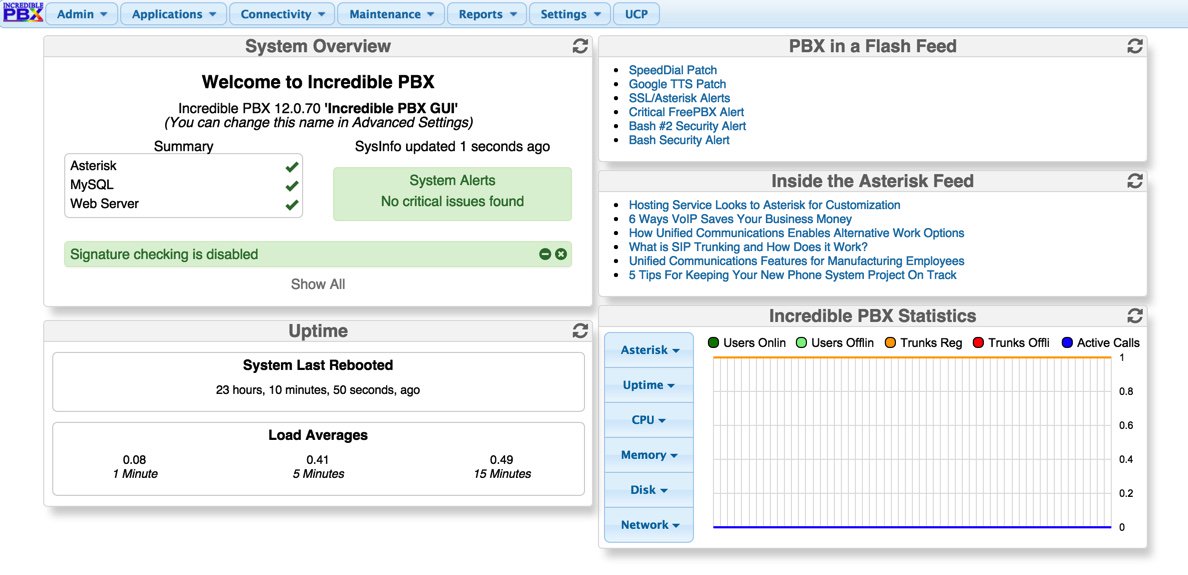
If you’re new to Asterisk and FreePBX, here’s the one paragraph primer on what needs to happen before you can make free calls with Google Voice. You’ll obviously need a free Google Voice account. This gets you a phone number for people to call you and a vehicle to place calls to plain old telephones throughout the U.S. and Canada at no cost. You’ll also need a softphone or SIP phone (NOT a regular POTS telephone) to actually place and receive calls. YATE makes a free softphone for PCs, Macs, and Linux machines so download your favorite and install it on your desktop. Phones connect to extensions to work with Incredible PBX. Extensions talk to trunks (like Google Voice) to make and receive calls. We use outbound routes to direct outgoing calls from extensions to trunks, and we use inbound routes to route incoming calls from trunks to extensions to make your phones ring. In a nutshell, that’s how a PBX works. There are lots of bells and whistles that you can explore down the road.
As configured after installation, you have everything you’ll need except a Google Voice trunk, and we’ll cover that next. Then we’ll add a softphone with your extension 701 credentials, and you’ll be ready to make and receive calls. Before we move on, let’s decipher your extension 701 password so that you’ll have it for later. Choose Applications -> Extensions -> 701 and scroll down the screen to the Secret field and write down your password. You can also change it if you like and click Submit and then the Red button to update your settings. While you’re here, write down your extension 701 Voicemail Password.
Deploying Google Voice on Your Server
That leaves one RED entry on your status display, GV OAUTH. Whether to use plain text passwords or OAUTH 2 credentials with Google Voice accounts presently is a matter of choice although Google regularly threatens to discontinue access to Google Voice without OAUTH authentication. We suggest you play with Google Voice using plain text passwords just to get your feet wet because OAUTH implementation gets complicated. When you get ready to deploy a permanent Incredible PBX server, that would be the appropriate time to switch to OAUTH. This tutorial (beginning at step 1b) will guide you through the process.
If you want to use Google Voice, you’ll need a dedicated Google Voice account to support Incredible PBX. If you want to use the inbound fax capabilities of Incredible Fax, then you’ll need an additional Google Voice line that can be routed to the FAX custom destination using the GUI. The more obscure the username (with some embedded numbers), the better off you will be. This will keep folks from bombarding you with unsolicited Gtalk chat messages, and who knows what nefarious scheme will be discovered using Google messaging six months from now. So keep this account a secret!
We’ve tested this extensively using an existing Gmail account, and inbound calling is just not reliable. The reason seems to be that Google always chooses Gmail chat as the inbound call destination if there are multiple registrations from the same IP address. So, be reasonable. Do it our way! Set up a dedicated Gmail and Google Voice account, and use it exclusively with Incredible PBX. It’s free at least through 2013. Google Voice no longer is by invitation only so, if you’re in the U.S. or have a friend that is, head over to the Google Voice site and register.
You must choose a telephone number (aka DID) for your new account, or Google Voice calling will not work… in either direction. Google used to permit outbound Gtalk calls using a fake CallerID, but that obviously led to abuse so it’s over! You also have to tie your Google Voice account to at least one working phone number as part of the initial setup process. Your cellphone number will work just fine. Don’t skip this step either. Just enter the provided 2-digit confirmation code when you tell Google to place the test call to the phone number you entered. Once the number is registered, you can disable it if you’d like in Settings, Voice Setting, Phones. But…
IMPORTANT: Be sure to enable the Google Chat option as one of your phone destinations in Settings, Voice Setting, Phones. That’s the destination we need for The Incredible PBX to work its magic! Otherwise, all inbound and outbound calls will fail. If you don’t see this option, you may need to call up Gmail and enable Google Chat there first. Then go back to the Google Voice Settings.
While you’re still in Google Voice Settings, click on the Calls tab. Make sure your settings match these:
- Call Screening – OFF
- Call Presentation – OFF
- Caller ID (In) – Display Caller’s Number
- Caller ID (Out) – Don’t Change Anything
- Do Not Disturb – OFF
- Call Options (Enable Recording) – OFF
- Global Spam Filtering – ON
Click Save Changes once you adjust your settings. Under the Voicemail tab, plug in your email address so you get notified of new voicemails. Down the road, receipt of a Google Voice voicemail will be a big hint that something has come unglued on your PBX.
One final word of caution is in order regardless of your choice of providers: Do NOT use special characters in any provider passwords, or nothing will work!
Once you have your Google Voice account properly configured with Google, here is the proper sequence to get a Google Voice account working with Incredible PBX. First, using a browser, login to your Google Voice account. Second, make sure that Google Chat is activated in your Phone -> Settings. Third, in a separate browser tab, enable Less Secure Apps for your Google account. Fourth, in another separate browser tab, activate the Google Voice reset procedure. Fifth, in the Incredible PBX GUI, choose Connectivity -> Google Voice (Motif) and enter your Google Voice credentials:
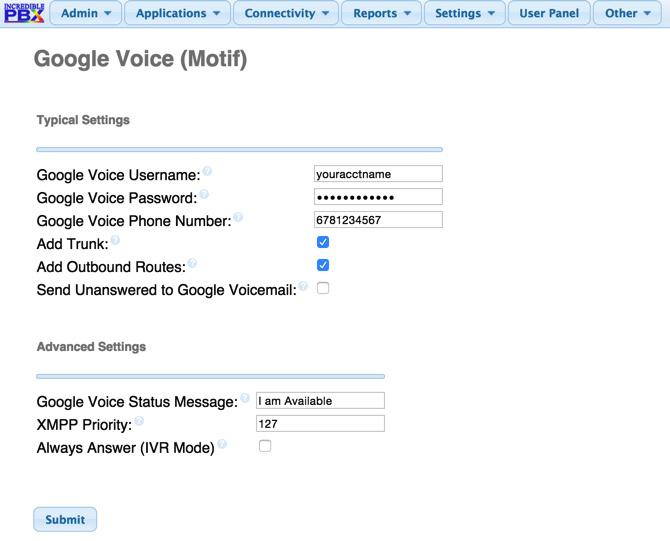
Sixth, save your settings by clicking Submit and the Red Button to reload the GUI. Finally, using SSH or Putty, log into your server as root and restart Asterisk: amportal restart.
Setting Up a Soft Phone to Use with Incredible PBX
Now you’re ready to set up a telephone so that you can play with Incredible PBX. We recommend YateClient which is free. Download it from here. Run YateClient once you’ve installed it and enter the credentials for the 701 extension on Incredible PBX. You’ll need the IP address of your server plus your extension 701 password. Choose Settings -> Accounts and click the New button. Fill in the blanks using the IP address of your server, 701 for your account name, and your extension 701 password. Click OK.
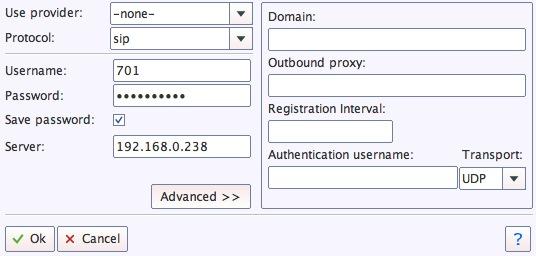
Once you are registered to extension 701, close the Account window. Then click on YATE’s Telephony Tab and place some test calls to the numerous apps that are preconfigured on Incredible PBX. Dial a few of these to get started:
DEMO - Allison's IVR Demo
947 - Weather by ZIP Code
951 - Yahoo News
*61 - Time of Day
*68 - Wakeup Call
TODAY - Today in History
Now you’re ready to connect to the telephones in the rest of the world. If you live in the U.S., the easiest way (at least for now) is to use the free Google Voice account we set up above. Unlike traditional telephone service where you were 100% dependent upon MaBell, there is no such limitation with VoIP. The smarter long-term solution is to choose several SIP providers and set up redundant trunks for your incoming and outbound calls. The PIAF Forum includes dozens of recommendations to get you started. Here are a few of our favorites:
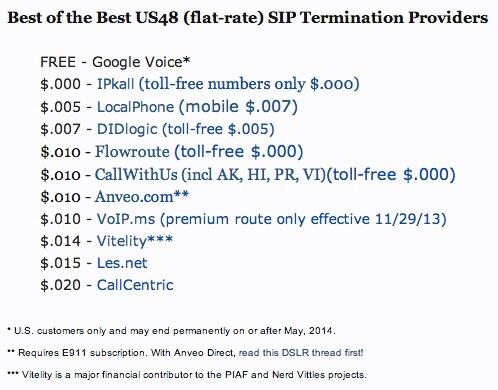
Originally published: Friday, January 29, 2016 Republished: Monday, March 14, 2016
9 Countries Have Never Visited Nerd Vittles. Got a Friend in Any of Them https://t.co/wMfmlhiQ9y #asterisk #freepbx pic.twitter.com/TPFGZbqWB6
— Ward Mundy (@NerdUno) April 22, 2016

Need help with Asterisk? Visit the PBX in a Flash Forum.
Special Thanks to Our Generous Sponsors
FULL DISCLOSURE: ClearlyIP, Skyetel, Vitelity, DigitalOcean, Vultr, VoIP.ms, 3CX, Sangoma, TelecomsXchange and VitalPBX have provided financial support to Nerd Vittles and our open source projects through advertising, referral revenue, and/or merchandise. As an Amazon Associate and Best Buy Affiliate, we also earn from qualifying purchases. We’ve chosen these providers not the other way around. Our decisions are based upon their corporate reputation and the quality of their offerings and pricing. Our recommendations regarding technology are reached without regard to financial compensation except in situations in which comparable products at comparable pricing are available from multiple sources. In this limited case, we support our sponsors because our sponsors support us.
 BOGO Bonaza: Enjoy state-of-the-art VoIP service with a $10 credit and half-price SIP service on up to $500 of Skyetel trunking with free number porting when you fund your Skyetel account. No limits on number of simultaneous calls. Quadruple data center redundancy. $25 monthly minimum spend required. Tutorial and sign up details are here.
BOGO Bonaza: Enjoy state-of-the-art VoIP service with a $10 credit and half-price SIP service on up to $500 of Skyetel trunking with free number porting when you fund your Skyetel account. No limits on number of simultaneous calls. Quadruple data center redundancy. $25 monthly minimum spend required. Tutorial and sign up details are here.
 The lynchpin of Incredible PBX 2020 and beyond is ClearlyIP components which bring management of FreePBX modules and SIP phone integration to a level never before available with any other Asterisk distribution. And now you can configure and reconfigure your new Incredible PBX phones from the convenience of the Incredible PBX GUI.
The lynchpin of Incredible PBX 2020 and beyond is ClearlyIP components which bring management of FreePBX modules and SIP phone integration to a level never before available with any other Asterisk distribution. And now you can configure and reconfigure your new Incredible PBX phones from the convenience of the Incredible PBX GUI.
 VitalPBX is perhaps the fastest-growing PBX offering based upon Asterisk with an installed presence in more than 100 countries worldwide. VitalPBX has generously provided a customized White Label version of Incredible PBX tailored for use with all Incredible PBX and VitalPBX custom applications. Follow this link for a free test drive!
VitalPBX is perhaps the fastest-growing PBX offering based upon Asterisk with an installed presence in more than 100 countries worldwide. VitalPBX has generously provided a customized White Label version of Incredible PBX tailored for use with all Incredible PBX and VitalPBX custom applications. Follow this link for a free test drive!
 Special Thanks to Vitelity. Vitelity is now Voyant Communications and has halted new registrations for the time being. Our special thanks to Vitelity for their unwavering financial support over many years and to the many Nerd Vittles readers who continue to enjoy the benefits of their service offerings. We will keep everyone posted on further developments.
Special Thanks to Vitelity. Vitelity is now Voyant Communications and has halted new registrations for the time being. Our special thanks to Vitelity for their unwavering financial support over many years and to the many Nerd Vittles readers who continue to enjoy the benefits of their service offerings. We will keep everyone posted on further developments.
Some Recent Nerd Vittles Articles of Interest…
I Have A Dream: Free Cellular Service with Integrated Remote SIP Connectivity
As part of our Mobile Internet adventure this year, we’ve been scouring the countryside with two requirements in mind. First, we wanted a smartphone on which we could activate some type of free cellular service for making calls and sending text messages. Second, we wanted to integrate remote SIP connectivity using the same provider and phone number so that we could make and receive calls transparently using any SIP phone or Asterisk® server anywhere in the world. Sounds like a tall order, you say? Well, if you’ve enjoyed your Cloud@Cost Sandbox, you’re gonna love RingPlus!
Yes, you’ll have to buy a compatible cellphone, but there are thousands to choose from. And, yes, you’ll need Sprint service in your neighborhood. Then you’ll have to cough up $10 to activate your cellular account. RingPlus offers dozens of plans.1 We recommend the Michelangelo plan which best meets what we’re trying to accomplish today, but the choice is all yours.2 With the Michelangelo plan, you can make and receive 1,000 minutes of free calls a month to anywhere in the U.S. (calls to Canada are 3¢ a minute), you can send and receive 1,000 free text messages a month, and you can use 500MB of free data service every month. You also can use your same account credentials with any SIP phone, softphone, or Asterisk server anywhere in the world to make and receive phone calls transparently using the same phone number as your smartphone. In other words, you can travel anywhere and make and receive phone calls just as if you were sitting in Atlanta, Georgia dialing from your smartphone. The SIP calls are deducted from your free minutes. No cellular service required at all. Meet RingPlus!
Starting at 3PM Eastern, free 1200 min./texts/MB cellular and/or SIP monthly https://t.co/l9It2xq14S #asterisk #voip pic.twitter.com/H6DP0sHuGx
— Ward Mundy (@NerdUno) February 9, 2016
So what’s the catch? How does RingPlus make money? Well, of course, they would prefer that you sign up for a plan with monthly fees. For those on the free plans, the only difference you will notice is an occasional ad which plays instead of a ring tone when you place outbound calls. This only occurs until the other party answers the call, and it can be all but eliminated by choosing a music selection in the RingPlus Radio feature in your RingPlus Dashboard.
Who are the ones most likely to use something like this? Well, for openers, all of your kids unless you like springing for a $500 phone and spending $40+ dollars a month for cellular service for each of them. One of the other real beauties of RingPlus is you can set up a whitelist of numbers that can be called from the phone. Blacklists are supported as well. It’s perfect for kids just getting started with a cellphone. A second potential user group would be those who travel outside the United States and prefer not to pay exorbitant roaming rates for calls. Using a SIP phone connected to your RingPlus account, all of the international calls suddenly are free. And the calls are delivered with the same CallerID number as calls placed from your actual smartphone. In fact, your smartphone doesn’t have to be in service at all. A third and perhaps most important use for us was to serve as a failover trunk on one or more Asterisk servers. When all else fails, you can route outbound calls to your RingPlus SIP trunk for free calling using your RingPlus account. Doesn’t get any better than that.
Official RingPlus WARNING: Starting April 17, 2016, per our carrier partner Sprint, Members and potential Members will no longer be able to activate prepaid devices which are not eligible under Sprint’s FED policies [Requires activation of prepaid phone on original Sprint MVNO network for at least one year!]. Such prepaid devices will no longer pass FED until actual eligibility date is met.
There are probably numerous ways to put all these pieces in place so that things function just as we’ve described. Today we’ll share with you the solution that actually worked for us. You can take it from there and avoid the thousands of horror stories about incompatible smartphones. Be advised that acquiring used cellphones or even incompatible cellphones is a very dangerous and expensive business. If you buy one that happens to be stolen, or that has a balance due on the account, or that is incompatible with RingPlus, then you’ve bought a tiny boat anchor and not much else. So, our best advice is buy one from the provider. That’s the one and only RingPlus, and the smartphones start at just under $100. Many Sprint post-paid phones also work, such as the new iPhone SE (Sprint Model) from any Apple Store.
If store employees will let you, find the Sprint postpaid phone that you like and look on the bottom of the box. There you will find the decimal value of the MEID. Log into http://nerd.bz/nvringplus and plug in the MEID to see if it is RingPlus compatible. If it passes, buy it. If it flunks, try another one. Whatever you do, DON’T BUY A PHONE IN AN OPENED BOX, AND DON’T OPEN THE BOX YET! Make certain there is a return policy in case things don’t work out as expected!
Funny story. The Radio Shack employees at our local store were very savvy and refused to let me look at the MEID claiming it was a security issue. Fair enough. Of course, they were also curious why I wanted a phone without letting them configure it. Once I told them the deal, they all wanted one, too. They asked for the link to the MEID verification site and said they’d do it for me. Once it worked, excitement broke out in the room with all the staff reading an early copy of this article. While Radio Shack typically charges a $35 restocking fee on cell phones, that fee is waived if you return the phone in an unopened box. So the only thing you’re wasting if they insist that you purchase the phone is a little bit of your time and a lot of Radio Shack employee time if, in fact, the MEID flunks the verification test.
Configuring Your Phone for RingPlus Service
Now sign up for a RingPlus free plan using the MEID and ICC ID you previously verified. Michelangelo is probably the best bet if you missed our Twitter tip this past weekend. Deposit $10 in your new account, and activate it. Log into your RingPlus Dashboard, click on your phone in the upper right frame, and choose Manage Device. Write down your MSID, your phone number, and MSL. Once your account is active, then and only then unbox and turn on your phone. Go through the minimal setup steps by choosing your Language and choosing an available WiFi network. During this setup, RingPlus should push a PRL update to your new phone, and it will reboot. Check in Settings -> General -> About Phone -> Status and see if you have a phone number. If so, you’re good to go. If not, open the Phone Dialer application and dial ##72786# which should force another PRL update to your phone with another reboot. When it finishes, check again for a phone number and place an outbound call.
Using a browser on your desktop computer, go back into the RingPlus Dashboard and sign in. Your phone device should show Active in the upper right corner of the screen. Click there and you’ll get a display like this:
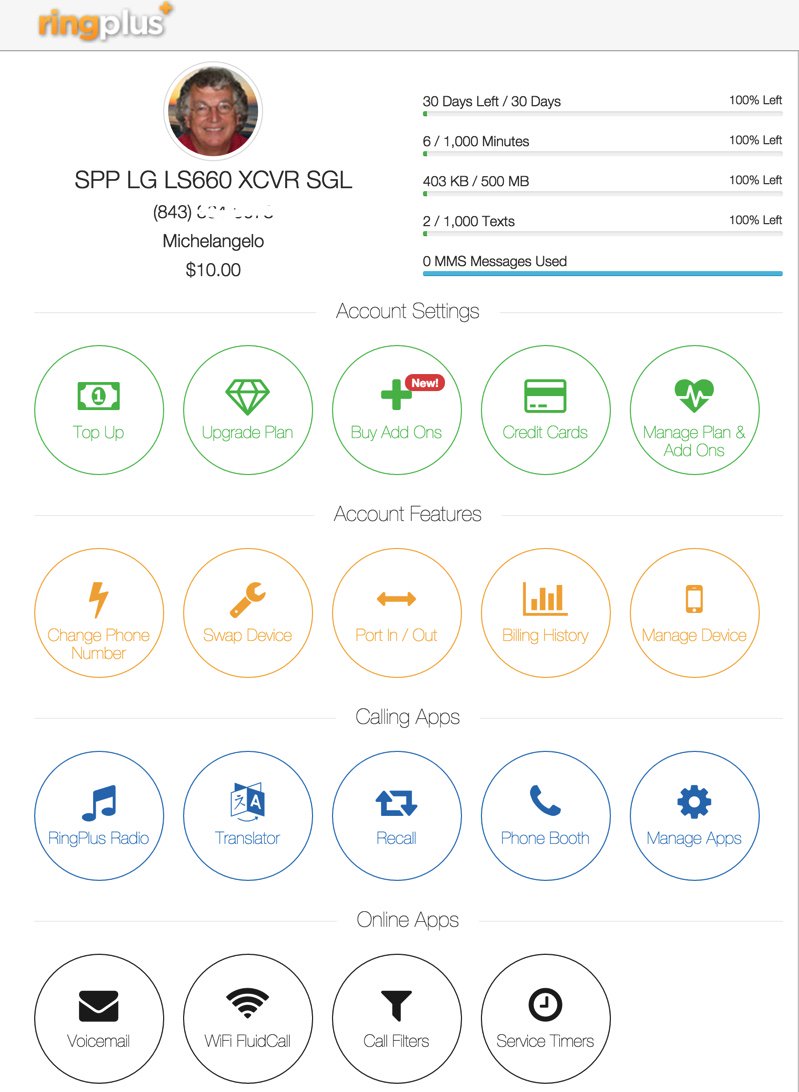
While still in the Device Settings Menu, click on the WiFi FluidCall option to decipher your SIP credentials. You’ll need these to set up your SIP phone or a SIP trunk on your Asterisk server. Your username is your 10-digit phone number, the domain name is sip.ringplus.net, and the password is a system-generated entry which you can recreate whenever you like. That’s probably a very good idea whenever you use public WiFi services to make calls with your SIP phone or a softphone.
By the way, this isn’t some kludgy SIP-GSM gateway where the calls actually are routed out through your cellphone device. The RingPlus SIP gateway connects your SIP device directly to the Internet and simply uses your existing RingPlus CallerID to identify the calls. In short, you get the best of both worlds: a dirt cheap or free cellphone service plus a dirt cheap or free SIP trunk for use anywhere in the world.
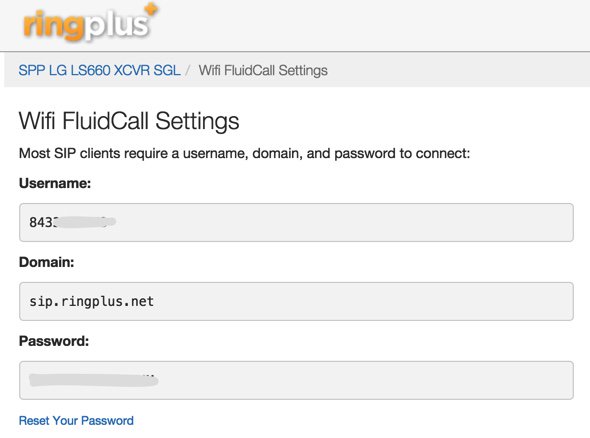
Configuring a RingPlus SIP Trunk with Asterisk
If you’d like to set up your RingPlus number as a failover trunk on your Asterisk server, here is the setup that worked for us with Incredible PBX using your assigned 10-digit phone number for your username and fromuser settings and your assigned password for your secret. If you include a registration string and configure an inbound route using your RingPlus DID, then inbound calling will work as well. If you skip the registration step, then you can use the same RingPlus trunk on multiple Asterisk servers for emergency outbound calling. No firewall adjustments should be necessary.
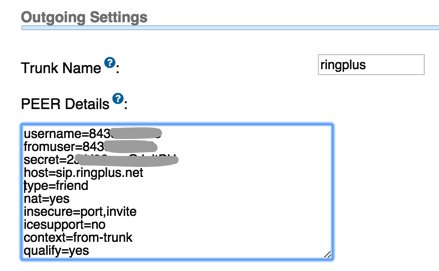
There are all sorts of other magic tricks you can implement using the RingPlus API, but you probably won’t need any of the features in light of the robust SIP connectivity RingPlus provides to an existing Asterisk server where the feature set is virtually unlimited. Be advised that you must make a call out at least once every 60 days to keep your account active. The simple way to do this is to set up a monthly reminder using your RingPlus trunk. Schedule the reminder to call out once every month using Telephone Reminders in Incredible PBX.
RingPlus Gotcha Checklist
Free service wouldn’t be free without a few land mines. So here’s a checklist to keep things running smoothly without any problems down the road. First, link your account to one of the social media options (Twitter, Facebook, or LinkedIn) when you sign up for service. You’ll find the link on your Dashboard under the Your Social Networks icon. Second, make at least one outbound call a month on every line you activate. As noted, this can be accomplished automatically using the Telephone Reminders application in Incredible PBX. Third, keep a valid credit card on file in your account at all times. Fourth, keep a positive balance in your account for each phone that you activate to avoid automatic replenishment at the original rate when you signed up for your plan. Fifth, be mindful of the Domino Effect. With some plans, if you allow a related plan to end (for example, Queen of Hearts when you also have an Ace of Hearts plan), then your better plan will be demoted in its feature set. Enjoy the Free Ride!
Originally published: Monday, February 8, 2016
9 Countries Have Never Visited Nerd Vittles. Got a Friend in Any of Them https://t.co/wMfmlhiQ9y #asterisk #freepbx pic.twitter.com/TPFGZbqWB6
— Ward Mundy (@NerdUno) April 22, 2016

Need help with Asterisk? Visit the PBX in a Flash Forum.
Special Thanks to Our Generous Sponsors
FULL DISCLOSURE: ClearlyIP, Skyetel, Vitelity, DigitalOcean, Vultr, VoIP.ms, 3CX, Sangoma, TelecomsXchange and VitalPBX have provided financial support to Nerd Vittles and our open source projects through advertising, referral revenue, and/or merchandise. As an Amazon Associate and Best Buy Affiliate, we also earn from qualifying purchases. We’ve chosen these providers not the other way around. Our decisions are based upon their corporate reputation and the quality of their offerings and pricing. Our recommendations regarding technology are reached without regard to financial compensation except in situations in which comparable products at comparable pricing are available from multiple sources. In this limited case, we support our sponsors because our sponsors support us.
 BOGO Bonaza: Enjoy state-of-the-art VoIP service with a $10 credit and half-price SIP service on up to $500 of Skyetel trunking with free number porting when you fund your Skyetel account. No limits on number of simultaneous calls. Quadruple data center redundancy. $25 monthly minimum spend required. Tutorial and sign up details are here.
BOGO Bonaza: Enjoy state-of-the-art VoIP service with a $10 credit and half-price SIP service on up to $500 of Skyetel trunking with free number porting when you fund your Skyetel account. No limits on number of simultaneous calls. Quadruple data center redundancy. $25 monthly minimum spend required. Tutorial and sign up details are here.
 The lynchpin of Incredible PBX 2020 and beyond is ClearlyIP components which bring management of FreePBX modules and SIP phone integration to a level never before available with any other Asterisk distribution. And now you can configure and reconfigure your new Incredible PBX phones from the convenience of the Incredible PBX GUI.
The lynchpin of Incredible PBX 2020 and beyond is ClearlyIP components which bring management of FreePBX modules and SIP phone integration to a level never before available with any other Asterisk distribution. And now you can configure and reconfigure your new Incredible PBX phones from the convenience of the Incredible PBX GUI.
 VitalPBX is perhaps the fastest-growing PBX offering based upon Asterisk with an installed presence in more than 100 countries worldwide. VitalPBX has generously provided a customized White Label version of Incredible PBX tailored for use with all Incredible PBX and VitalPBX custom applications. Follow this link for a free test drive!
VitalPBX is perhaps the fastest-growing PBX offering based upon Asterisk with an installed presence in more than 100 countries worldwide. VitalPBX has generously provided a customized White Label version of Incredible PBX tailored for use with all Incredible PBX and VitalPBX custom applications. Follow this link for a free test drive!
 Special Thanks to Vitelity. Vitelity is now Voyant Communications and has halted new registrations for the time being. Our special thanks to Vitelity for their unwavering financial support over many years and to the many Nerd Vittles readers who continue to enjoy the benefits of their service offerings. We will keep everyone posted on further developments.
Special Thanks to Vitelity. Vitelity is now Voyant Communications and has halted new registrations for the time being. Our special thanks to Vitelity for their unwavering financial support over many years and to the many Nerd Vittles readers who continue to enjoy the benefits of their service offerings. We will keep everyone posted on further developments.
Some Recent Nerd Vittles Articles of Interest…
- Be advised that future upgrades of these "free" plans may go away after February 15 unless you join the Member+ program, the cost of which changes almost weekly. This will not affect those that already are participating in the program according to RingPlus. [↩]
- In case you’re curious, a plan equivalent to the free Michelangelo plan at RingPlus would run you $41.00 per month at Ting. Ouch! [↩]
The Ultimate Linux Sandbox in the Cloud for Less Than a $35 Raspberry Pi 2

Every few years we like to drop back and take a fresh look at the best way to get started with Linux. For those coming from the Windows World, it can be a painful process. Learning with a Cloud-based server can be especially dangerous because of the security risks. And then there’s the cost factor. Not everyone has several hundred dollars to buy hardware and, frankly, learning about Linux on a $35 Raspberry Pi can drive most newbies to drink. So today we’ll show you another way. It’s not necessarily a better way. But it’s different, and it’s loads of fun for not much money. Today’s project only takes 30 minutes.
There’s lots to hate at Cloud At Cost, a Canadian provider that offers virtual machines in the cloud for a one-time fee with no recurring charges. For $35 or less, you get a virtual machine with 512MB of RAM, 10GB of storage, and a gigabit Internet connection FOR LIFE. We haven’t seen a week go by when Cloud at Cost didn’t offer some sort of discount. Today it’s 70% off with coupon code TAKE70 which brings the total cost down to $10.50. That’s less than a burger at Five Guys. That’s the good news. But, if security, 99.999% reliability, performance, and excellent customer support are your must-haves, then look elsewhere. So why would anyone in their right mind sign up for a cloud solution that didn’t offer those four things? Did we mention it’s $10.50 for a lifetime cloud server?
If you take our recommendation and plunk down your Alexander Hamilton, you’ll need to go into this with the right attitude. It’s not going to be flawless perfection computing. It’s a sandbox on which to experiment with Linux and Cloud Computing. Will your virtual machine disintegrate at some juncture? Probably. Our experience is that the first couple days are critical. If you start seeing sluggish performance which degenerates to zero, don’t waste your time. Take good notes as you go along, delete the virtual machine, and rebuild a new one. It won’t cost you a dime, and it’ll save you hours of frustration. We suspect that bad folks get onto some of the servers and delight in bringing the machines to their knees. So the quicker you cut your losses, the better off you will be. Is CloudAtCost a good solution for production use? Absolutely not so don’t try to fit a square peg in the round hole. It’s not gonna work, and you WILL be disappointed. You’ve been warned. Let’s get started. ENJOY THE RIDE!
Our objective today is to show you how to build a rock-solid, secure Linux server in the Cloud with all the bells and whistles that make Linux the server platform of choice for almost every organization in the world. We’ll finish up by showing you how to embellish the platform with WordPress to do something that’s special for you whether it’s your own blog like Nerd Vittles, or a school newspaper, or an on-line shopping site to sell comic books. The basic foundation for most Linux platforms is called a LAMP server which stands for Linux, Apache, MySQL, and PHP. Linux is an open source operating system that includes contributions from thousands of developers around the world. Apache is the web server platform on which most commercial businesses stake their reputation. MySQL is the open source database management system now owned by Oracle. If it’s good enough for Facebook, it’s good enough for you. And PHP is THE web-based programming language that will let you build almost any application using Linux, Apache, and MySQL.
So what’s the big deal? There are thousands of online tutorials that will show you how to build a LAMP server. For long time readers of Nerd Vittles, you already know that the component we continually stress is security. Without that, the rest really doesn’t matter. You’ll be building a platform for someone else to hijack and use for nefarious purposes. When we’re finished today, you’ll have a cloud-based server that is totally invisible to the rest of the world with the exception of its web interface. And we’ll show you a simple way to reduce the exposure of your web interface to some of its most likely attackers. Will it be 100% secure? Nope. If you have a web server on the public Internet, it’s never going to be 100% secure because there’s always the chance of a software bug that nobody has yet discovered and corrected. THAT’S WHAT BACKUPS ARE FOR!
Creating Your Virtual Machine Platform in the Cloud
To get started, you’ve got to plunk down your $10.50 at Cloud at Cost using coupon code TAKE70. Once you’ve paid the piper, they will send you credentials to log into the Cloud at Cost Management Portal. Change your password IMMEDIATELY after logging in. Just go to SETTINGS and follow your nose.

To create your virtual machine, click on the CLOUDPRO button and click Add New Server. If you’ve only purchased the $10.50 CloudPRO 1 platform, then you’ll need all of the available resources shown in the pick list. Leave CentOS 6.7 64bit selected as the OS Type and click Complete. Depending upon the type of special pricing that Cloud at Cost is offering when you sign up, the time to build your virtual machine can take anywhere from a minute to the better part of a day. We’ve learned to build new virtual machines at night, and they’re usually available for use by the next morning. Luckily, this slow performance does not impact existing virtual machines that already are running in their hosting facility.
Initial Configuration of Your CentOS 6.7 Virtual Machine

With a little luck, your virtual machine soon will appear in your Cloud at Cost Management Portal and look something like what’s shown above. The red arrow points to the i button you’ll need to click to decipher the password for your new virtual machine. You’ll need both the IP address and the password for your new virtual machine in order to log into the server which is now up and running with a barebones CentOS 6.7 operating system. Note the yellow caution flag. That’s telling you that Cloud at Cost will automatically shut down your server in a week to save (them) computing resources. You can change the setting to keep your server running 24/7. Click Modify, Change Run Mode, and select Normal – Leave Powered On. Click Continue and OK to save your new settings.

Finally, you’ll want to change the Host Name for your server to something more descriptive than c7…cloudpro.92… Click the Modify button again and click Rename Server to make the change. Your management portal then will show the new server name as shown above.
Logging into Your CentOS 6.7 Virtual Machine
In order to configure and manage your new CentOS 6.7 virtual machine, you’ll need to log into the new server using either SSH or, for Windows users, Putty. After installing Putty, run it and log in to the IP address of your VM with username root and the password you deciphered above. On a Mac, open a Terminal session and issue a command like this using the actual IP address of your new virtual machine:
ssh root@12.34.56.78
Before you do anything else, reset your root password to something very secure: passwd
Installing the LAMP Server Basics with CentOS 6.7
Now we’re ready to build your LAMP server platform. We’ve chopped this up into lots of little steps so we can explain what’s happening as we go along. There’s nothing hard about this, but we want to document the process so you can repeat it at any time. As we go along, just cut-and-paste each clump of code into your SSH or Putty session and review the results to make sure nothing comes unglued. If something does, the beauty of virtual machines is you can delete them instantly within your management portal and just start over whenever you like. So here we go…
We’ll begin by permanently turning off SELINUX which causes more problems than it solves. The first command turns it off instantly. The second line assures that it’ll stay off whenever you reboot your virtual machine.
setenforce 0 sed -i s/SELINUX=enforcing/SELINUX=disabled/g /etc/selinux/config
Now let’s bring CentOS 6.7 up to current specs and add a few important applications:
yum -y update yum -y install nano wget expect net-tools dialog git xz yum -y install kernel-headers yum -y install kernel-devel reboot
After reboot, log back in as root. Now we’ll set up your Apache web server and configure it to start whenever you reboot your server:
yum -y install httpd service httpd start chkconfig httpd on
Now let’s set up your MySQL server, bring it on line, and make sure it restarts after server reboots. Unless you plan to add Asterisk® and FreePBX® to your server down the road, you’ll want to uncomment the two commands that begin with # by removing the # symbol and replacing new-password with a very secure password for your root user account in MySQL. Be sure to run the last command to secure your server. After logging in, the correct answers are n,Y,Y,Y,Y.
yum -y install mysql mysql-server service mysqld start chkconfig mysqld on #/usr/bin/mysqladmin -u root password 'new-password' #/usr/bin/mysqladmin -u root -p -h localhost.localdomain password 'new-password' mysql_secure_installation
Next, we’ll set up PHP and configure it to work with MySQL:
yum -y install php yum -y install php-mysql service httpd restart
Finally let’s get SendMail installed and configured. Insert your actual email address in the last line and send yourself a test message to be sure it’s working. Be sure to check your spam folder since the message will show a sender address of localhost which many email systems including Gmail automatically identify as spam.
yum -y install sendmail rpm -e postfix service sendmail restart yum -y install mailx echo "test" | mail -s testmessage youracctname@yourmailserver.com
Installing Supplemental Repositories for CentOS 6.7
One of the beauties of Linux is not being totally dependent upon CentOS for all of your packaged applications. Let’s add a few other repositories that can be used when you need to add a special package that is not in the CentOS repository. Let’s start with EPEL. We’ll disable it by default and only use it when we need it.
yum -y install http://download.fedoraproject.org/pub/epel/6/x86_64/epel-release-6-8.noarch.rpm sed -i 's|enabled=1|enabled=0|' /etc/yum.repos.d/epel.repo
We actually need the EPEL repo to install Fail2Ban for monitoring of attacks on certain Linux services such as SSH:
yum --enablerepo=epel install fail2ban -y cd /etc wget http://incrediblepbx.com/fail2ban-lamp.tar.gz tar zxvf fail2ban-lamp.tar.gz
We also need the EPEL repo to install ipset, a terrific addition to the IPtables Linux firewall that lets you quickly block entire countries from accessing your server:
yum --enablerepo=epel install ipset -y
Next, we’ll add a sample script that documents how the country blocking mechanism works with ipset.1 For a complete list of countries that can be blocked, go here. If you need a decoder badge to match abbreviations against country names, you’ll find it here. To add other countries, simply edit the shell script and clone lines 4-7 using the names of the countries and country zone files that you wish to add. Be sure to insert the new lines before the commands to restart iptables and fail2ban. This script will need to be run each time your server reboots and before IPtables is brought on line. We’ll handle that a little later.
echo "#\\!/bin/bash" > /etc/block-china.sh echo " " >> /etc/block-china.sh echo "cd /etc" >> /etc/block-china.sh echo "ipset -N china hash:net" >> /etc/block-china.sh echo "rm cn.zone" >> /etc/block-china.sh echo "wget -P . http://www.ipdeny.com/ipblocks/data/countries/cn.zone" >> /etc/block-china.sh echo "for i in \$(cat /etc/cn.zone ); do ipset -A china \$i; done" >> /etc/block-china.sh echo "service iptables restart" >> /etc/block-china.sh echo "service fail2ban restart" >> /etc/block-china.sh sed -i 's|\\\\||' /etc/block-china.sh chmod +x /etc/block-china.sh
Another important repository is REMI. It is especially helpful if you decide to upgrade PHP from the default version 5.3 to one of the newer releases: 5.5 or 5.6. In this case, you’ll want to activate the specific repository to support the release you choose in /etc/yum.repos.d/remi-safe.repo.
yum -y install http://rpms.famillecollet.com/enterprise/remi-release-6.rpm sed -i 's|enabled=1|enabled=0|' /etc/yum.repos.d/remi-safe.repo
One final repository to have on hand is RPMForge, now renamed RepoForge. We’ll use it in a bit to install a dynamic DNS update utility which you actually won’t need at CloudAtCost since your server is assigned a static IP address. But it’s handy to have in the event you wish to assign a free FQDN to your server anyway.
yum -y install http://incrediblepbx.com/rpmforge-release-0.5.3-1.el6.rf.x86_64.rpm sed -i 's|enabled = 1|enabled = 0|' /etc/yum.repos.d/rpmforge.repo
Adding a Few Utilities to Round Out Your LAMP Server Deployment
If you’re like us, you’ll want to test the speed of your Internet connection from time to time. Let’s install a free script that you can run at any time by logging into your server as root and issuing the command: /root/speedtest-cli
cd /root wget https://raw.githubusercontent.com/sivel/speedtest-cli/master/speedtest.py chmod +x speedtest.py

Next, let’s put in place a simple status display which will quickly tell you what’s running and what’s not. We’ve borrowed some GPL code from Incredible PBX to help you out. Run status-lamp at any time for a snapshot of your server.
cd /usr/local/sbin wget http://incrediblepbx.com/status-lamp.tar.gz tar zxvf status-lamp.tar.gz rm -f status-lamp.tar.gz sed -i 's|myip.pbxinaflash.com|myip.incrediblepbx.com|' /usr/local/sbin/status-lamp

Now we’ll put the Linux Swiss Army Knife in place. It’s called WebMin, and it provides a GUI to configure almost everything in Linux. Pick up a good WebMin book from your public library to get started. Once installed, you access WebMin from your browser at the IP address of your server on the default port of 10000: https://serverIPaddress:10000. It’s probably a good idea to change this port number and the commented out line shows how to do it with the new port being 9001 in the example. The way in which we typically configure the Linux firewall will block all access to WebMin except from an IP address which you have whitelisted, e.g. your home computer’s public IP address.
cd /root yum -y install perl perl-Net-SSLeay openssl perl-IO-Tty yum -y install http://prdownloads.sourceforge.net/webadmin/webmin-1.780-1.noarch.rpm #sed -i 's|10000|9001|g' /etc/webmin/miniserv.conf service webmin restart chkconfig webmin on

Tweaking Your CloudAtCost Setup Improves Performance and Improves Security
Finally, let’s address a couple of CloudAtCost quirks that may cause problems down the road. CloudAtCost has a nasty habit of not cleaning up after itself with fresh installs. The net result is your root password gets reset every time you reboot.
killall plymouthd echo killall plymouthd >> /etc/rc.local rm -f /etc/rc3.d/S97*
With the exception of firewall configuration, which is so important that we’re covering it separately below, you now have completed the LAMP server installation. After completing the firewall steps in the next section, simply reboot your server and you’re ready to go.
The Most Important Step: Configuring the Linux IPtables Firewall
RULE #1: DON’T BUILD SERVERS EXPOSED TO THE INTERNET WITHOUT ROCK-SOLID SECURITY!
As installed by CloudAtCost, your server provides ping and SSH access from a remote computer and nothing else. The good news: it’s pretty safe. The bad news: it can’t do anything useful for anybody because all web access to the server is blocked. We want to fix that, tighten up SSH access to restrict it to your IP address, and deploy country blocking to show you how.
As we implement the firewall changes, you need to be extremely careful in your typing so that you don’t accidentally lock yourself out of your own server. A typo in an IP address is all it takes. The good news is that, if you do lock yourself out, you still can gain access via the CloudAtCost Management Portal by clicking the Console button of your virtual machine. Because the console is on the physical machine and the lo interface is whitelisted, you can log in and disable the firewall temporarily: service iptables stop. Then fix the typo and restart the firewall: service iptables start.
First, let’s download the new IPtables config file into your root folder and take a look at it.
cd /root wget http://incrediblepbx.com/iptables-lamp.tar.gz tar zxvf iptables-lamp.tar.gz
Now edit the /root/iptables-lamp file by issuing the command: nano -w /root/iptables-lamp
You can scroll up and down through the file with Ctl-V and Ctl-Y. Cursor keys work as well. Once you make changes, save your work: Ctl-X, Y, ENTER. You’re now an expert with the nano text editor, an absolutely essential Linux tool.
Here’s what that file actually looks like:
*filter :INPUT DROP [0:0] :FORWARD ACCEPT [0:0] :OUTPUT ACCEPT [0:0] -A INPUT -p tcp -m tcp --tcp-flags ACK ACK -j ACCEPT -A INPUT -m state --state ESTABLISHED,RELATED -j ACCEPT -A INPUT -p icmp -j DROP -A INPUT -i lo -j ACCEPT -A INPUT -p tcp ! --syn -m state --state NEW -j DROP -A INPUT -m state --state INVALID -j DROP -A INPUT -p tcp -m tcp --tcp-flags FIN,SYN,RST,PSH,ACK,URG NONE -j DROP -A INPUT -p tcp -m tcp --tcp-flags SYN,FIN SYN,FIN -j DROP -A INPUT -p tcp -m tcp --tcp-flags SYN,RST SYN,RST -j DROP -A INPUT -p tcp -m tcp --tcp-flags FIN,RST FIN,RST -j DROP -A INPUT -p tcp -m tcp --tcp-flags ACK,FIN FIN -j DROP -A INPUT -p tcp -m tcp --tcp-flags ACK,URG URG -j DROP -A INPUT -p tcp -m set --match-set china src -j DROP -A INPUT -p udp -m udp --dport 53 -j ACCEPT -A INPUT -p tcp -m tcp --dport 53 -j ACCEPT -A INPUT -p tcp -m tcp --dport 113 -j ACCEPT -A INPUT -p udp -m udp --dport 123 -j ACCEPT -A INPUT -p tcp -m tcp --dport 123 -j ACCEPT -A INPUT -m state --state NEW -m tcp -p tcp --dport 22 -j ACCEPT #-A INPUT -s 12.34.56.78 -j ACCEPT #-A INPUT -s yourFQDN.dyndns.org -j ACCEPT -A INPUT -p tcp -m tcp --dport 80 -j ACCEPT -A INPUT -j REJECT --reject-with icmp-host-prohibited -A FORWARD -j REJECT --reject-with icmp-host-prohibited COMMIT
Reminder: If you add another country to your block-china script, don’t forget to add a corresponding new country entry to your iptables file. See line 17 above that includes the word "china" for the syntax. There’s nothing much else to tweak except the two commented out (brown) lines that begin with #. First, remove the # symbol by moving the cursor to the right of the first one and hitting the backspace/delete key on your keyboard. Replace 12.34.56.78 with the public IP address of the computer from which you will be accessing your virtual machine. If you need multiple entries for multiple computers at different addresses, clone the line by pressing Ctrl-K and then Ctrl-U twice. Yes, we know. Some folks IP addresses change from time to time. In the next section, we’ll show you how to set up a Dynamic DNS entry with a utility that will keep track of your current IP address. In this case, uncomment the second commented line and replace yourFQDN.dyndns.org with your dynamic DNS address. Be very careful to assure that your FQDN is always on line. If the firewall cannot verify your DNS entry when it starts, the IPtables firewall will not start which means your server will be left unprotected. HINT: IP addresses are much safer because they are never verified.
Once you have your addresses configured, save the file: Ctl-X, Y, ENTER. Then issue the following commands to copy everything into place and restart the firewall.
mv /etc/sysconfig/iptables /etc/sysconfig/iptables.orig cp -p /root/iptables-lamp /etc/sysconfig/iptables echo "/etc/block-china.sh" >> /etc/rc.local /etc/block-china.sh
Always, always, always check to be sure your firewall is functioning: iptables -nL. If you don’t see your desktop computer’s public IP address near the end of the listing, then the firewall is dead. status-lamp should also show IPtables down. Check for an error message which will tell you the problematic line so you can correct it.
Implementing Dynamic DNS Service on Your Virtual Machine
There are a number of free and paid Dynamic DNS providers. The way this works is you choose a fully-qualified domain name (FQDN) to identify your computer. Then you run a dynamic DNS update utility periodically from that computer. It reports back the current public IP address of your computer and your provider updates the IP address assigned to your FQDN if it has changed. In addition to supporting sites with ever changing IP addresses, it also allows you to permanently assign an FQDN to your computer or server so that it can be accessed without using a cryptic IP address.
If that computer happens to be an Incredible PBX server or a LAMP server that you’ve set up using this tutorial, then the following will get the DNS client update utility loaded using the RPM Forge repository that we previously installed:
yum --enablerepo=rpmforge install ddclient -y
Similar DNS update clients are available for Windows, Mac OS X, and many residential routers. Then it’s just a matter of plugging in the credentials for your dynamic DNS provider and your FQDN. In the case of the CentOS client, the config file is /etc/ddclient/ddclient.conf. Now reboot your server and pick up a good book on Linux to begin your adventure.
Now For Some Fun…
First, let’s check things out and make sure everything is working as it should. With your favorite web browser, visit the IP address of your new server. You should see the default Apache page:

Next, let’s be sure that PHP is working as it should. While still logged into your server as root using SSH or Putty, issue the following commands and make up some file name to replace test4567 in both lines. Be sure to keep the .php file name extension. Note to gurus: Yes, we know the second line below is unnecessary if you remove the space after the less than symbol in the first line. Unfortunately, WordPress forces the space into the display which left us no alternative.
echo "< ?php phpinfo(); ?>" > /var/www/html/test4567.php sed -i 's|< |<|' /var/www/html/test4567.php
Now jump back to your web browser and access the new page you just created using the IP address of your server and the file name you made up: http://12.34.56.78/test4567.php
The PHPinfo listing will tell you everything you ever wanted to know about your web server setup including all of the PHP functions that have been enabled. That's why you want an obscure file name for the page. You obviously don't want to share that information with every bad guy on the planet. Remember. This is a public-facing web site that anyone on the Internet can access if they know or guess your IP address.

When you're ready to set up your own web site, just name it index.php and store the file in the /var/www/html directory of your server. In the meantime, issuing the following command will assure that anyone accessing your site gets a blank page until you're ready to begin your adventure:
echo " " > /var/www/html/index.php
Ready to learn PHP programming? There's no shortage of books to get you started.
Adding WordPress to Your LAMP Server
Where to begin with WordPress? What used to be a simple platform for bloggers has morphed into an all-purpose tool that makes building virtually any type of web site child's play. If you want to see what's possible, take a look at the templates and sample sites shown on WPZOOM. Unless you're an art major and savvy web designer, this will be the best $70 you ever spent. One of these templates will have your site up and running in minutes once we put the WordPress pieces in place. For the big spenders, $149 will give you access to over 50 gorgeous templates which you can download and use to your heart's content on multiple sites. And, no, your sites don't blow up after a year. You just can't download any additional templates or updates unless you renew your subscription. The other alternative is choose from thousands of templates that are provided across the Internet as well as in the WordPress application itself.
WordPress templates run the gamut from blogs to newsletters to photographer sites to e-commerce to business portfolios to video to travel to magazines to newspapers to education to food to recipes to restaurants and more. Whew! There literally is nothing you can't put together in minutes using a WordPress template. But, before you can begin, we need to get WordPress installed on your server. This is optional, of course. And, if you follow along and add WordPress, we've set it up in such a way that WordPress becomes the primary application for your site. Stated differently, when people use a browser to access your site, your WordPress template will immediately display. When we finish the basic WordPress setup and once you upload an image or two, you'll have a site that looks something like this:

Before you begin, we strongly recommend that you acquire a domain for your site if you plan to use it for anything but experimentation. The reason is because it can be complicated to migrate a WordPress site from one location to another.2 Once you've acquired your domain, point the domain to the IP address of your new server. With a dirt cheap registrar such as Omnis.com, it's easy:

Now let's get started. To begin, we need to load the WordPress application onto your server:
cd /root mkdir wordpress cd wordpress wget http://wordpress.org/latest.tar.gz tar -xvzf latest.tar.gz -C /var/www/html
Next, we'll configure MySQL to support WordPress. We're assuming that you have NOT already created root passwords for MySQL. If you have, you'll need to add -pYourPassword to the various commands below immediately after root. There is no space between -p and your root password. Also edit the first line and make up a new password (replacing XYZ below) for the wordpress user account that will manage WordPress on your server before you cut and paste the code:
mysql -u root -e 'CREATE USER wordpress@localhost IDENTIFIED BY "XYZ";' mysql -u root -e 'CREATE DATABASE wordpress;' mysql -u root -e 'GRANT ALL ON wordpress.* TO wordpress@localhost;' mysql -u root -e 'FLUSH PRIVILEGES;'
Next, we need to configure WordPress with your new MySQL credentials. Before you cut and paste, replace XYZ in the fourth line with the password you assigned in the preceding MySQL step:
cp /var/www/html/wordpress/wp-config-sample.php /var/www/html/wordpress/wp-config.php sed -i 's|database_name_here|wordpress|' /var/www/html/wordpress/wp-config.php sed -i 's|username_here|wordpress|' /var/www/html/wordpress/wp-config.php sed -i 's|password_here|XYZ|' /var/www/html/wordpress/wp-config.php chown -R apache:apache /var/www/html/wordpress
Before you forget, take a moment and create a very secure password for your MySQL root user accounts. Here are the commands. Just replace new-password with your new password before you cut and paste. Note that you also will be prompted for this password when you execute the second command because you will now have a root user password in place from executing the first command.
/usr/bin/mysqladmin -u root password 'new-password' /usr/bin/mysqladmin -u root -p -h localhost.localdomain password 'new-password'
Finally, we need to modify your Apache web server to support WordPress as the primary application. Be sure to enter your actual email address in the third line before you cut and paste the code below:
echo " " >> /etc/httpd/conf/httpd.conf echo "" >> /etc/httpd/conf/httpd.conf echo 'ServerAdmin somebody@somedomain.com' >> /etc/httpd/conf/httpd.conf echo "DocumentRoot /var/www/html/wordpress" >> /etc/httpd/conf/httpd.conf echo "ServerName wordpress" >> /etc/httpd/conf/httpd.conf echo "ErrorLog /var/log/httpd/wordpress-error-log" >> /etc/httpd/conf/httpd.conf echo "CustomLog /var/log/httpd/wordpress-acces-log common" >> /etc/httpd/conf/httpd.conf echo " " >> /etc/httpd/conf/httpd.conf echo " " >> /etc/httpd/conf/httpd.conf service httpd restart
That should do it. Open a browser and navigate to the IP address of your server. You should be greeted with the following form. Fill in the blanks as desired. The account you're setting up will be the credentials you use to add and modify content on your WordPress site when you click Log In (as shown above). Make the username obscure and the password even more so. Remember, it's a public web site accessible worldwide! When you click Install WordPress, you'll be off to the races.

After your server whirs away for a minute or two, you will be greeted with the WordPress login prompt. With the username and password you entered above, you'll be ready to start configuring your WordPress site.

Once you're logged in, navigate to Appearance -> Themes and click Add New Theme. There's you will find literally hundreds of free WordPress templates that can be installed in a matter of seconds if WPZOOM is too rich for your blood. For a terrific all-purpose (free) theme, try Atahualpa. We'll leave our actual demo site running for a bit in case you want to explore and check out its performance. Installing and configuring the new theme took less than a minute:

A Final Word to the Wise. WordPress is relatively secure but new vulnerabilities are discovered regularly. Keep your templates, plug-ins, AND the WordPress application up to date at all times! The WordFence plug-in is a must-have. And we strongly recommend adding the following lines to your WordPress config file which then will let WordPress update everything automatically. Microsoft has given automatic updates a bad name, but in the case of WordPress, they work well.
echo "define('WP_AUTO_UPDATE_CORE', true);" >> /var/www/html/wordpress/wp-config.php
echo "add_filter( 'auto_update_plugin', '__return_true' );" >> /var/www/html/wordpress/wp-config.php
echo "add_filter( 'auto_update_theme', '__return_true' );" >> /var/www/html/wordpress/wp-config.php
Special Thanks: Our special tip of the hat goes to a few web sites that we found helpful in putting this article together especially Unixmen and Matt Wilcox & friends and Programming-Review.
Wondering What to Build Next with your new $10.50 Server in the Sky? Check out the latest Nerd Vittles tutorial. Turn it into a VoIP server FOR LIFE with free calling to/from the U.S. and Canada. Call for free demo: 
TAKE70: Build a VoIP Server in the Cloud FOR LIFE w/ Free US/CAN calling https://t.co/l9It2xq14S #asterisk #freepbx pic.twitter.com/UYuCMcfEn8
— Ward Mundy (@NerdUno) January 31, 2016
Originally published: Monday, January 25, 2016
9 Countries Have Never Visited Nerd Vittles. Got a Friend in Any of Them https://t.co/wMfmlhiQ9y #asterisk #freepbx pic.twitter.com/TPFGZbqWB6
— Ward Mundy (@NerdUno) April 22, 2016

Need help with Asterisk? Visit the PBX in a Flash Forum.
Special Thanks to Our Generous Sponsors
FULL DISCLOSURE: ClearlyIP, Skyetel, Vitelity, DigitalOcean, Vultr, VoIP.ms, 3CX, Sangoma, TelecomsXchange and VitalPBX have provided financial support to Nerd Vittles and our open source projects through advertising, referral revenue, and/or merchandise. As an Amazon Associate and Best Buy Affiliate, we also earn from qualifying purchases. We’ve chosen these providers not the other way around. Our decisions are based upon their corporate reputation and the quality of their offerings and pricing. Our recommendations regarding technology are reached without regard to financial compensation except in situations in which comparable products at comparable pricing are available from multiple sources. In this limited case, we support our sponsors because our sponsors support us.
 BOGO Bonaza: Enjoy state-of-the-art VoIP service with a $10 credit and half-price SIP service on up to $500 of Skyetel trunking with free number porting when you fund your Skyetel account. No limits on number of simultaneous calls. Quadruple data center redundancy. $25 monthly minimum spend required. Tutorial and sign up details are here.
BOGO Bonaza: Enjoy state-of-the-art VoIP service with a $10 credit and half-price SIP service on up to $500 of Skyetel trunking with free number porting when you fund your Skyetel account. No limits on number of simultaneous calls. Quadruple data center redundancy. $25 monthly minimum spend required. Tutorial and sign up details are here.
 The lynchpin of Incredible PBX 2020 and beyond is ClearlyIP components which bring management of FreePBX modules and SIP phone integration to a level never before available with any other Asterisk distribution. And now you can configure and reconfigure your new Incredible PBX phones from the convenience of the Incredible PBX GUI.
The lynchpin of Incredible PBX 2020 and beyond is ClearlyIP components which bring management of FreePBX modules and SIP phone integration to a level never before available with any other Asterisk distribution. And now you can configure and reconfigure your new Incredible PBX phones from the convenience of the Incredible PBX GUI.
 VitalPBX is perhaps the fastest-growing PBX offering based upon Asterisk with an installed presence in more than 100 countries worldwide. VitalPBX has generously provided a customized White Label version of Incredible PBX tailored for use with all Incredible PBX and VitalPBX custom applications. Follow this link for a free test drive!
VitalPBX is perhaps the fastest-growing PBX offering based upon Asterisk with an installed presence in more than 100 countries worldwide. VitalPBX has generously provided a customized White Label version of Incredible PBX tailored for use with all Incredible PBX and VitalPBX custom applications. Follow this link for a free test drive!
 Special Thanks to Vitelity. Vitelity is now Voyant Communications and has halted new registrations for the time being. Our special thanks to Vitelity for their unwavering financial support over many years and to the many Nerd Vittles readers who continue to enjoy the benefits of their service offerings. We will keep everyone posted on further developments.
Special Thanks to Vitelity. Vitelity is now Voyant Communications and has halted new registrations for the time being. Our special thanks to Vitelity for their unwavering financial support over many years and to the many Nerd Vittles readers who continue to enjoy the benefits of their service offerings. We will keep everyone posted on further developments.
Some Recent Nerd Vittles Articles of Interest...
- It doesn't take long for the probing to begin. So watch your logs, look up the IP addresses to identify the countries, and block them unless you happen to be expecting visitors from that part of the world:
[Sun Jan 24 00:36:12 2016] [error] [client 40.114.202.60] File does not exist: /var/www/html/wordpress/w00tw00t.at.blackhats.romanian.anti-sec:)[↩]
[Sun Jan 24 00:36:12 2016] [error] [client 40.114.202.60] File does not exist: /var/www/html/wordpress/phpMyAdmin
[Sun Jan 24 00:36:13 2016] [error] [client 40.114.202.60] File does not exist: /var/www/html/wordpress/phpmyadmin
[Sun Jan 24 00:36:13 2016] [error] [client 40.114.202.60] File does not exist: /var/www/html/wordpress/pma
[Sun Jan 24 00:36:13 2016] [error] [client 40.114.202.60] File does not exist: /var/www/html/wordpress/myadmin
[Sun Jan 24 00:36:14 2016] [error] [client 40.114.202.60] File does not exist: /var/www/html/wordpress/MyAdmin
[Mon Jan 25 00:29:29 2016] [error] [client 137.116.220.182] File does not exist: /var/www/html/wordpress/w00tw00t.at.blackhats.romanian.anti-sec:)
[Mon Jan 25 00:29:29 2016] [error] [client 137.116.220.182] File does not exist: /var/www/html/wordpress/phpMyAdmin
[Mon Jan 25 00:29:29 2016] [error] [client 137.116.220.182] File does not exist: /var/www/html/wordpress/phpmyadmin
[Mon Jan 25 00:29:30 2016] [error] [client 137.116.220.182] File does not exist: /var/www/html/wordpress/pma
[Mon Jan 25 00:29:30 2016] [error] [client 137.116.220.182] File does not exist: /var/www/html/wordpress/myadmin
[Mon Jan 25 00:29:30 2016] [error] [client 137.116.220.182] File does not exist: /var/www/html/wordpress/MyAdmin
- Should you ever have to migrate your WordPress site from one domain to another, here are two helpful tools to consider: the Automatic Domain Name Changer Plugin and the one we use, WordPress-Domain-Changer. [↩]


 JUST RELEASED: Visit the Incredible PBX Wiki
JUST RELEASED: Visit the Incredible PBX Wiki